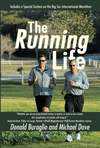Donald Buraglio and Michael Dove's Blog, page 28
May 13, 2011
Blogger Meltdown; Random Shots of Beauty
*tap, tap, tap* … Is this thing on??
The "big news for me that honestly isn't that big" from Thursday and Friday was the brief implosion of Blogger, which went completely off the grid for nearly 24 hours, and caused all posts which had been published within the 30 or so hours prior to the shutdown to completely vanish – including the just-about-final draft of a cool product review I had scheduled for Friday morning.
Consequently, the posting schedule's getting shuffled around a bit this weekend, and the review post (which I fortunately had saved as a Word document) will show up here Sunday night. In the meantime, I'm doing the customary weekend Random Shot of Beauty, but including a bonus Random Video of Awesomeness that originated in the same venue. And hopefully nobody at Blogger will accidentally spill Mountain Dew on the mainframe anymore … because I kind of didn't know what to do with myself this week in those awful hours when my virtual world went dark. I wish I were exaggerating.
*
The Random Shot of Beauty is an easy one: a leftover shot from last weekend's Miwok 100K:

A view of Point Reyes as seen from the hillside high above Stinson Beach. It tells you something about the beauty of the Miwok course that this picture didn't make the race report.
**
As for the Random Video of Awesomeness, it was filmed by Jim Vernon of a Bay Area trail running group called The Endurables, and it chronicles the race among the leaders throughout the day at Miwok. It's simply mind-boggling to realize how fast these dudes are moving, especially when you see them in person and note how effortless they make it look. Even though we were in the exact same race that day, these guys and I were doing completely different sports.
"Miwok 100K 2011" by The Endurables (click to play):
Get updates as soon as they're posted! Click here to subscribe to Running and Rambling.
Check out the Running Life book for a collection of our most popular columns.

The "big news for me that honestly isn't that big" from Thursday and Friday was the brief implosion of Blogger, which went completely off the grid for nearly 24 hours, and caused all posts which had been published within the 30 or so hours prior to the shutdown to completely vanish – including the just-about-final draft of a cool product review I had scheduled for Friday morning.
Consequently, the posting schedule's getting shuffled around a bit this weekend, and the review post (which I fortunately had saved as a Word document) will show up here Sunday night. In the meantime, I'm doing the customary weekend Random Shot of Beauty, but including a bonus Random Video of Awesomeness that originated in the same venue. And hopefully nobody at Blogger will accidentally spill Mountain Dew on the mainframe anymore … because I kind of didn't know what to do with myself this week in those awful hours when my virtual world went dark. I wish I were exaggerating.
*
The Random Shot of Beauty is an easy one: a leftover shot from last weekend's Miwok 100K:

A view of Point Reyes as seen from the hillside high above Stinson Beach. It tells you something about the beauty of the Miwok course that this picture didn't make the race report.
**
As for the Random Video of Awesomeness, it was filmed by Jim Vernon of a Bay Area trail running group called The Endurables, and it chronicles the race among the leaders throughout the day at Miwok. It's simply mind-boggling to realize how fast these dudes are moving, especially when you see them in person and note how effortless they make it look. Even though we were in the exact same race that day, these guys and I were doing completely different sports.
"Miwok 100K 2011" by The Endurables (click to play):
Get updates as soon as they're posted! Click here to subscribe to Running and Rambling.
Check out the Running Life book for a collection of our most popular columns.

Published on May 13, 2011 22:51
May 10, 2011
An Architect in Moccasins: Miwok 100K Race Report
"Do you still believe in all the things that you stood by before –
Are you out there on the front lines, or at home keeping score?
Do you care to be the layer of the bricks that seal your fate?
Or would you rather be the architect of what we might create?"
- Rise Against, "Architects" (video after post)
The first time I came to Miwok, I was building up to my maiden 100-mile race, and hadn't quite fully wrapped my head around the huge numbers involved beyond the realm of the 50-milers I was familiar with. I believed that getting to 100 miles was possible, but aside from that, I didn't have any tangible experience to base that confidence upon.
It was only during that initial 100K that I got my first taste of what the 100-miler might have in store – in both good ways and bad. So with another 100-miler on my schedule this summer, one of my top priorities was to make it to Miwok again, to see if I still had that same belief in myself, and to hopefully get a glimpse of what kind of experience I might be able to create later this year.
With a few more races under my belt now – and for another reason I'll describe shortly - I'm a different runner than I was the first time here. As it turns out, Miwok was a little different as well; this year's course included some new trails and a couple of route changes, but still packed about 10,000' of climbing into some of the most scenic trails in Northern California. The day promised a lot of great things to see – and with that, we'll start the report.
(As usual, click any of these photos to enlarge ...)
 You'll be forgiven for thinking this is the start line: a bunch of people standing around, chatting the time away, making nervous jokes to take their mind off the situation at hand. Unfortunately, when I took this photo, the race was more than 5 minutes old; after a scramble across the sand of Rodeo Beach, the route immediately narrows to a single-track climb where people in back of the crowd are forced to stop in their tracks for at least a few more minutes before slowly proceeding up the hill. Since it's the first half-mile of a 62-mile race, and since none of the people in the group around me were exactly charging for a podium finish, nobody really seemed to mind the brief delay.
You'll be forgiven for thinking this is the start line: a bunch of people standing around, chatting the time away, making nervous jokes to take their mind off the situation at hand. Unfortunately, when I took this photo, the race was more than 5 minutes old; after a scramble across the sand of Rodeo Beach, the route immediately narrows to a single-track climb where people in back of the crowd are forced to stop in their tracks for at least a few more minutes before slowly proceeding up the hill. Since it's the first half-mile of a 62-mile race, and since none of the people in the group around me were exactly charging for a podium finish, nobody really seemed to mind the brief delay.
 Once you make it up the first trail, you hit a paved road where you can look back at the start area behind you …
Once you make it up the first trail, you hit a paved road where you can look back at the start area behind you …
 … which is a lot more attractive than the long grind up Conzelman Road ahead.
… which is a lot more attractive than the long grind up Conzelman Road ahead.
 The reward for climbing up Conzelman is pretty sweet: a killer vantage point of the Golden Gate Bridge emerging from the morning fog.
The reward for climbing up Conzelman is pretty sweet: a killer vantage point of the Golden Gate Bridge emerging from the morning fog.
 After seeing the bridge, the trail winds its way gently downhill again …
After seeing the bridge, the trail winds its way gently downhill again …
 … until you reach a "Wait – weren't we just here?" moment in returning to the Rodeo Beach aid station at mile 7. The good news is that you don't have to wait five minutes to cross the beach a second time. The bad news is, you have to cross the beach a second time.
… until you reach a "Wait – weren't we just here?" moment in returning to the Rodeo Beach aid station at mile 7. The good news is that you don't have to wait five minutes to cross the beach a second time. The bad news is, you have to cross the beach a second time.
 Leaving Rodeo Beach (for good this time), this year's route generally took us in reverse through the final section of the traditional race. In my previous Miwok report, I griped about having to go down this large stone staircase at mile 61; this year, we went up them instead. Don't be shocked when I say this … but it turns out that up is harder.
Leaving Rodeo Beach (for good this time), this year's route generally took us in reverse through the final section of the traditional race. In my previous Miwok report, I griped about having to go down this large stone staircase at mile 61; this year, we went up them instead. Don't be shocked when I say this … but it turns out that up is harder.
 Climbing the first ridge gives you a glimpse of Tennessee Valley, and you get to enjoy another long downhill to the aid station there. By this point of the race, your legs and mind may as well get used to the pattern: long grinding uphills, followed by long steady downhills – because that's pretty much what you spend the day doing out here.
Climbing the first ridge gives you a glimpse of Tennessee Valley, and you get to enjoy another long downhill to the aid station there. By this point of the race, your legs and mind may as well get used to the pattern: long grinding uphills, followed by long steady downhills – because that's pretty much what you spend the day doing out here.
 After Tennessee Valley comes the longest section of the race without aid; an 8.9-mile up and down stretch including wide ridgeline fire roads …
After Tennessee Valley comes the longest section of the race without aid; an 8.9-mile up and down stretch including wide ridgeline fire roads …
 … and twisty-turny singletrack …
… and twisty-turny singletrack …
 … and some sweet forest trails with foliage overhead and wildflowers underfoot. Believe it or not, you haven't even reached the prettiest sections of the course yet.
… and some sweet forest trails with foliage overhead and wildflowers underfoot. Believe it or not, you haven't even reached the prettiest sections of the course yet.
 That starts shortly after leaving the Pan Toll aid station at mile 20, where you see the first of two landscapes that Miwok is famous for: plush shady trails meandering through giant redwood forests.
That starts shortly after leaving the Pan Toll aid station at mile 20, where you see the first of two landscapes that Miwok is famous for: plush shady trails meandering through giant redwood forests.
 Ahh, the Dipsea Trail … such great memories.
Ahh, the Dipsea Trail … such great memories.
 Here's the second landscape that defines Miwok: grassy single-track on the high slopes of Marin County, with a beautiful seascape in the distance below. You can't gaze at the sea for too long, however …
Here's the second landscape that defines Miwok: grassy single-track on the high slopes of Marin County, with a beautiful seascape in the distance below. You can't gaze at the sea for too long, however …
 … because long portions of this section include what locals call "half-track" trail, which because of its narrowness and slope has been known to roll more than a few ankles over the years.
… because long portions of this section include what locals call "half-track" trail, which because of its narrowness and slope has been known to roll more than a few ankles over the years.
 Each time I've done Miwok, the hardest section mentally is the long out and back from the Bolinas Ridge aid station at mile 27 to the turnaround point of the course at mile 34. Fortunately, I didn't have any thoughts of quitting the race here – because as this sign (click to enlarge photo) outside the aid station says, I would have ended up with a wrinkled soul. Nobody needs that.
Each time I've done Miwok, the hardest section mentally is the long out and back from the Bolinas Ridge aid station at mile 27 to the turnaround point of the course at mile 34. Fortunately, I didn't have any thoughts of quitting the race here – because as this sign (click to enlarge photo) outside the aid station says, I would have ended up with a wrinkled soul. Nobody needs that.
 The forest somehow vanishes about 500' from the Randall Trail turnaround point, which at Miwok signals the bonus good news that you've actually done more than half the distance. For some reason, that knowledge is always very reassuring.
The forest somehow vanishes about 500' from the Randall Trail turnaround point, which at Miwok signals the bonus good news that you've actually done more than half the distance. For some reason, that knowledge is always very reassuring.
 Remember how I mentioned I was a different runner now? That wasn't just because I'm a couple of years older and have a few more races on my resume. I was also doing the race in Soft Star RunAmocs, for which I've made no secret of my affection over the past year. This spring I had an idea to spread the love a little more publicly than my little hole-in-the-Internet-wall, and the elves at Soft Star were completely on board, sending me a race shirt and setting me up with fresh mocs shortly before race day.
Remember how I mentioned I was a different runner now? That wasn't just because I'm a couple of years older and have a few more races on my resume. I was also doing the race in Soft Star RunAmocs, for which I've made no secret of my affection over the past year. This spring I had an idea to spread the love a little more publicly than my little hole-in-the-Internet-wall, and the elves at Soft Star were completely on board, sending me a race shirt and setting me up with fresh mocs shortly before race day.
Knowing that this is probably the closest I'll ever come to actually being a sponsored runner, I figured I'd start calling myself Team Soft Star, since "that crazy guy in the moccasins" doesn't quite have the same ring to it. At Miwok, I was the poster boy for RunAmocs – and honestly, I had a ton of discussions about them on the trail. For the most part, the ultrarunning community has been incredibly curious and open-minded about the whole minimalist thing, and my reception at Miwok was wonderful, for two primary reasons:
1) More than virtually anyone else, ultrarunners can certainly identify with hearing people tell them that something they want to do is crazy, impossible, or potentially harmful – and then going ahead and doing it anyway. Also …
2) Recall that I started at the very back of the pack, which means that I passed a lot of people throughout the day. I imagine that it's hard to question whether something is effective when the guy doing it is pulling away from you.
So there you have it: Team Soft Star, coming to a trail near you someday. Meanwhile, back at the race …
 Even though you've turned the corner towards home, returning from Randall Trail is still a fairly significant challenge, as you climb two solid miles through the redwoods before finishing the "more up than down" roller coaster route back to Bolinas Ridge at mile 41.
Even though you've turned the corner towards home, returning from Randall Trail is still a fairly significant challenge, as you climb two solid miles through the redwoods before finishing the "more up than down" roller coaster route back to Bolinas Ridge at mile 41.
 While the out and back is the toughest mental section for me, the mostly uphill 6-mile return through the half-track and single-track toward Pan Toll was without a doubt the toughest physical section. The incline is just steep enough to grind you down, but just gentle enough that you feel guilty for walking it. This is where I struggled the most, and where I ultimately resorted to gameplay with the two runners in this picture.
While the out and back is the toughest mental section for me, the mostly uphill 6-mile return through the half-track and single-track toward Pan Toll was without a doubt the toughest physical section. The incline is just steep enough to grind you down, but just gentle enough that you feel guilty for walking it. This is where I struggled the most, and where I ultimately resorted to gameplay with the two runners in this picture.
They passed me while I was taking a photo, and I made a concerted effort to catch back up and settle in behind them. The girl was running the whole race, but the guy was her pacer, so he had fresh legs and great energy and kept a steady pace while engaging her in conversation the whole way. I asked if I could tag along, and mentally latched onto them like the caboose of a train; my only goal through the whole section was to stay close enough for them to pull me. This was a significant turning point for me; if I had fallen back, the race very likely could have turned ugly, but by making the extra effort to stay close, I made it through my roughest patch of the course without slowing down at all. For that, I was grateful, and I made sure to thank them both afterward.
 Leaving the Pan Toll aid station at mile 48, you're welcomed with a 2-mile downhill stretch …
Leaving the Pan Toll aid station at mile 48, you're welcomed with a 2-mile downhill stretch …
 … followed by a pretty section of flat single track on your way to Muir Beach. This was one of the only level sections on the course, with a nice smooth trail, and when I passed through the wind began swirling at my back, with cloud cover briefly gaining the upper hand over the sun. It was like the ultra gods were smiling on me …
… followed by a pretty section of flat single track on your way to Muir Beach. This was one of the only level sections on the course, with a nice smooth trail, and when I passed through the wind began swirling at my back, with cloud cover briefly gaining the upper hand over the sun. It was like the ultra gods were smiling on me …
 … and when I got to Muir Beach at mile 54, the aid station people were cheering for me. I mean … how much better can an ultra get?
… and when I got to Muir Beach at mile 54, the aid station people were cheering for me. I mean … how much better can an ultra get?
 Since the course had changed this year, Miwok's homestretch featured a gauntlet of major climbs, beginning with this one right after the aid station …
Since the course had changed this year, Miwok's homestretch featured a gauntlet of major climbs, beginning with this one right after the aid station …
 … where you start with a nice view of Muir Beach below, and then head higher up the hill …
… where you start with a nice view of Muir Beach below, and then head higher up the hill …
 … to get your first view of Pirates Cove, one of the prettiest sections of coastline in Marin County. It's best to keep your gaze fixed on the shore, though …
… to get your first view of Pirates Cove, one of the prettiest sections of coastline in Marin County. It's best to keep your gaze fixed on the shore, though …
 … because if it drifts inland a bit, you might feel a stomach punch sensation after seeing the climb out of Pirates Cove that awaits you another mile or two ahead.
… because if it drifts inland a bit, you might feel a stomach punch sensation after seeing the climb out of Pirates Cove that awaits you another mile or two ahead.
 The good part of the Pirates Cove climb is that every now and then you can look over your shoulder and enjoy the view below …
The good part of the Pirates Cove climb is that every now and then you can look over your shoulder and enjoy the view below …
 … because keeping your eyes fixed uphill might get discouraging.
… because keeping your eyes fixed uphill might get discouraging.
 Once you've finally climbed out of Pirates Cove, you've got less than 10K left to go – and when you see the mile 58 Tennessee Valley aid station down below, you can begin to smell the barn.
Once you've finally climbed out of Pirates Cove, you've got less than 10K left to go – and when you see the mile 58 Tennessee Valley aid station down below, you can begin to smell the barn.
 I mean that literally, because Tennessee Valley has a lot of barns. And horses. Horses that smell. It's also home to some wild critters …
I mean that literally, because Tennessee Valley has a lot of barns. And horses. Horses that smell. It's also home to some wild critters …
 … such as this kitty who didn't seem too bothered by a moccasin-clad runner trudging up behind him. Then again, I can't imagine why he would be.
… such as this kitty who didn't seem too bothered by a moccasin-clad runner trudging up behind him. Then again, I can't imagine why he would be.
 Predictably, there's another long climb out of Tennessee Valley …
Predictably, there's another long climb out of Tennessee Valley …
 … followed by another long descent to sea level. On the original course, once you reach sea level here, you're done – but this year the finish wasn't at Rodeo Beach – it was at the local YMCA …
… followed by another long descent to sea level. On the original course, once you reach sea level here, you're done – but this year the finish wasn't at Rodeo Beach – it was at the local YMCA …
 … which was up and over these hills in the Point Bonita area. I generally love exploring new trails – but when I'm looking for the finish line after running 60 miles and all the new trails seem to lead uphill, my enthusiasm tends to wane just a little bit.
… which was up and over these hills in the Point Bonita area. I generally love exploring new trails – but when I'm looking for the finish line after running 60 miles and all the new trails seem to lead uphill, my enthusiasm tends to wane just a little bit.
 The reward for your final climb is one last view of the Golden Gate …
The reward for your final climb is one last view of the Golden Gate …
 … and a downward sloping road to Point Bonita just ahead.
… and a downward sloping road to Point Bonita just ahead.
 Considering that this is a world-famous race, the finish line at Miwok is quite unpretentious: there's a clock, a line drawn on the ground, and a few people standing around clapping. I crossed the line 11 hours and 35 minutes after starting, giving me a nearly 15-minute improvement over the previous time I was here, which felt pretty nice …
Considering that this is a world-famous race, the finish line at Miwok is quite unpretentious: there's a clock, a line drawn on the ground, and a few people standing around clapping. I crossed the line 11 hours and 35 minutes after starting, giving me a nearly 15-minute improvement over the previous time I was here, which felt pretty nice …
 … but not nearly as nice as the hot showers that were available after the race. Before showering, though, I had to take a couple more pictures …
… but not nearly as nice as the hot showers that were available after the race. Before showering, though, I had to take a couple more pictures …
 … like this one of Team Soft Star at the finish line. I won't claim that it was easy to run this course in moccasins – but I can definitely say that my feet didn't hurt any more than the rest of me. I had some soreness through my ankles and on the bottom of my feet, but it was generally the same kind of muscle soreness that you get after any super-long workout.
… like this one of Team Soft Star at the finish line. I won't claim that it was easy to run this course in moccasins – but I can definitely say that my feet didn't hurt any more than the rest of me. I had some soreness through my ankles and on the bottom of my feet, but it was generally the same kind of muscle soreness that you get after any super-long workout.
 What I didn't have were blisters or any major hot spots, and my Drymax socks did a perfect job of protecting me from dust and grit coming through the perforated leather. (I'm not talented enough to be on Team Drymax, though – they have plenty of real ultrarunners onboard.) The mocs were more than up to the task of getting me through 62 miles of hilly, occasionally rocky and technical terrain – I couldn't really ask for more.
What I didn't have were blisters or any major hot spots, and my Drymax socks did a perfect job of protecting me from dust and grit coming through the perforated leather. (I'm not talented enough to be on Team Drymax, though – they have plenty of real ultrarunners onboard.) The mocs were more than up to the task of getting me through 62 miles of hilly, occasionally rocky and technical terrain – I couldn't really ask for more.
I'll have a follow-up post or two in the near future about where the whole RunAmoc thing goes from here. In some ways, it ties back into the same notion I started this report with: testing the limits of what's possible, and gradually converting belief into tangible accomplishment one mile at a time. I hadn't officially wrapped my head around the idea of doing 100 miles in moccasins prior to this race, but Miwok clearly gave me the confidence to at least consider it. Between now and July, perhaps it's time for me to be an architect who dreams of something remarkable that I just might be able to create in the mountains above Lake Tahoe.
*
"We still believe in all the things that we stood by before –
And after everything we've seen here maybe even more."
Rise Against, "Architects" (click to play; lyrics advisory):
*See other race reports under tab at top of page
Get updates as soon as they're posted! Click here to subscribe to Running and Rambling.
Check out the Running Life book for a collection of our most popular columns.


Are you out there on the front lines, or at home keeping score?
Do you care to be the layer of the bricks that seal your fate?
Or would you rather be the architect of what we might create?"
- Rise Against, "Architects" (video after post)
The first time I came to Miwok, I was building up to my maiden 100-mile race, and hadn't quite fully wrapped my head around the huge numbers involved beyond the realm of the 50-milers I was familiar with. I believed that getting to 100 miles was possible, but aside from that, I didn't have any tangible experience to base that confidence upon.
It was only during that initial 100K that I got my first taste of what the 100-miler might have in store – in both good ways and bad. So with another 100-miler on my schedule this summer, one of my top priorities was to make it to Miwok again, to see if I still had that same belief in myself, and to hopefully get a glimpse of what kind of experience I might be able to create later this year.
With a few more races under my belt now – and for another reason I'll describe shortly - I'm a different runner than I was the first time here. As it turns out, Miwok was a little different as well; this year's course included some new trails and a couple of route changes, but still packed about 10,000' of climbing into some of the most scenic trails in Northern California. The day promised a lot of great things to see – and with that, we'll start the report.
(As usual, click any of these photos to enlarge ...)
 You'll be forgiven for thinking this is the start line: a bunch of people standing around, chatting the time away, making nervous jokes to take their mind off the situation at hand. Unfortunately, when I took this photo, the race was more than 5 minutes old; after a scramble across the sand of Rodeo Beach, the route immediately narrows to a single-track climb where people in back of the crowd are forced to stop in their tracks for at least a few more minutes before slowly proceeding up the hill. Since it's the first half-mile of a 62-mile race, and since none of the people in the group around me were exactly charging for a podium finish, nobody really seemed to mind the brief delay.
You'll be forgiven for thinking this is the start line: a bunch of people standing around, chatting the time away, making nervous jokes to take their mind off the situation at hand. Unfortunately, when I took this photo, the race was more than 5 minutes old; after a scramble across the sand of Rodeo Beach, the route immediately narrows to a single-track climb where people in back of the crowd are forced to stop in their tracks for at least a few more minutes before slowly proceeding up the hill. Since it's the first half-mile of a 62-mile race, and since none of the people in the group around me were exactly charging for a podium finish, nobody really seemed to mind the brief delay. Once you make it up the first trail, you hit a paved road where you can look back at the start area behind you …
Once you make it up the first trail, you hit a paved road where you can look back at the start area behind you … … which is a lot more attractive than the long grind up Conzelman Road ahead.
… which is a lot more attractive than the long grind up Conzelman Road ahead. The reward for climbing up Conzelman is pretty sweet: a killer vantage point of the Golden Gate Bridge emerging from the morning fog.
The reward for climbing up Conzelman is pretty sweet: a killer vantage point of the Golden Gate Bridge emerging from the morning fog. After seeing the bridge, the trail winds its way gently downhill again …
After seeing the bridge, the trail winds its way gently downhill again … … until you reach a "Wait – weren't we just here?" moment in returning to the Rodeo Beach aid station at mile 7. The good news is that you don't have to wait five minutes to cross the beach a second time. The bad news is, you have to cross the beach a second time.
… until you reach a "Wait – weren't we just here?" moment in returning to the Rodeo Beach aid station at mile 7. The good news is that you don't have to wait five minutes to cross the beach a second time. The bad news is, you have to cross the beach a second time. Leaving Rodeo Beach (for good this time), this year's route generally took us in reverse through the final section of the traditional race. In my previous Miwok report, I griped about having to go down this large stone staircase at mile 61; this year, we went up them instead. Don't be shocked when I say this … but it turns out that up is harder.
Leaving Rodeo Beach (for good this time), this year's route generally took us in reverse through the final section of the traditional race. In my previous Miwok report, I griped about having to go down this large stone staircase at mile 61; this year, we went up them instead. Don't be shocked when I say this … but it turns out that up is harder. Climbing the first ridge gives you a glimpse of Tennessee Valley, and you get to enjoy another long downhill to the aid station there. By this point of the race, your legs and mind may as well get used to the pattern: long grinding uphills, followed by long steady downhills – because that's pretty much what you spend the day doing out here.
Climbing the first ridge gives you a glimpse of Tennessee Valley, and you get to enjoy another long downhill to the aid station there. By this point of the race, your legs and mind may as well get used to the pattern: long grinding uphills, followed by long steady downhills – because that's pretty much what you spend the day doing out here. After Tennessee Valley comes the longest section of the race without aid; an 8.9-mile up and down stretch including wide ridgeline fire roads …
After Tennessee Valley comes the longest section of the race without aid; an 8.9-mile up and down stretch including wide ridgeline fire roads … … and twisty-turny singletrack …
… and twisty-turny singletrack … … and some sweet forest trails with foliage overhead and wildflowers underfoot. Believe it or not, you haven't even reached the prettiest sections of the course yet.
… and some sweet forest trails with foliage overhead and wildflowers underfoot. Believe it or not, you haven't even reached the prettiest sections of the course yet. That starts shortly after leaving the Pan Toll aid station at mile 20, where you see the first of two landscapes that Miwok is famous for: plush shady trails meandering through giant redwood forests.
That starts shortly after leaving the Pan Toll aid station at mile 20, where you see the first of two landscapes that Miwok is famous for: plush shady trails meandering through giant redwood forests. Ahh, the Dipsea Trail … such great memories.
Ahh, the Dipsea Trail … such great memories. Here's the second landscape that defines Miwok: grassy single-track on the high slopes of Marin County, with a beautiful seascape in the distance below. You can't gaze at the sea for too long, however …
Here's the second landscape that defines Miwok: grassy single-track on the high slopes of Marin County, with a beautiful seascape in the distance below. You can't gaze at the sea for too long, however … … because long portions of this section include what locals call "half-track" trail, which because of its narrowness and slope has been known to roll more than a few ankles over the years.
… because long portions of this section include what locals call "half-track" trail, which because of its narrowness and slope has been known to roll more than a few ankles over the years. Each time I've done Miwok, the hardest section mentally is the long out and back from the Bolinas Ridge aid station at mile 27 to the turnaround point of the course at mile 34. Fortunately, I didn't have any thoughts of quitting the race here – because as this sign (click to enlarge photo) outside the aid station says, I would have ended up with a wrinkled soul. Nobody needs that.
Each time I've done Miwok, the hardest section mentally is the long out and back from the Bolinas Ridge aid station at mile 27 to the turnaround point of the course at mile 34. Fortunately, I didn't have any thoughts of quitting the race here – because as this sign (click to enlarge photo) outside the aid station says, I would have ended up with a wrinkled soul. Nobody needs that. The forest somehow vanishes about 500' from the Randall Trail turnaround point, which at Miwok signals the bonus good news that you've actually done more than half the distance. For some reason, that knowledge is always very reassuring.
The forest somehow vanishes about 500' from the Randall Trail turnaround point, which at Miwok signals the bonus good news that you've actually done more than half the distance. For some reason, that knowledge is always very reassuring. Remember how I mentioned I was a different runner now? That wasn't just because I'm a couple of years older and have a few more races on my resume. I was also doing the race in Soft Star RunAmocs, for which I've made no secret of my affection over the past year. This spring I had an idea to spread the love a little more publicly than my little hole-in-the-Internet-wall, and the elves at Soft Star were completely on board, sending me a race shirt and setting me up with fresh mocs shortly before race day.
Remember how I mentioned I was a different runner now? That wasn't just because I'm a couple of years older and have a few more races on my resume. I was also doing the race in Soft Star RunAmocs, for which I've made no secret of my affection over the past year. This spring I had an idea to spread the love a little more publicly than my little hole-in-the-Internet-wall, and the elves at Soft Star were completely on board, sending me a race shirt and setting me up with fresh mocs shortly before race day.Knowing that this is probably the closest I'll ever come to actually being a sponsored runner, I figured I'd start calling myself Team Soft Star, since "that crazy guy in the moccasins" doesn't quite have the same ring to it. At Miwok, I was the poster boy for RunAmocs – and honestly, I had a ton of discussions about them on the trail. For the most part, the ultrarunning community has been incredibly curious and open-minded about the whole minimalist thing, and my reception at Miwok was wonderful, for two primary reasons:
1) More than virtually anyone else, ultrarunners can certainly identify with hearing people tell them that something they want to do is crazy, impossible, or potentially harmful – and then going ahead and doing it anyway. Also …
2) Recall that I started at the very back of the pack, which means that I passed a lot of people throughout the day. I imagine that it's hard to question whether something is effective when the guy doing it is pulling away from you.
So there you have it: Team Soft Star, coming to a trail near you someday. Meanwhile, back at the race …
 Even though you've turned the corner towards home, returning from Randall Trail is still a fairly significant challenge, as you climb two solid miles through the redwoods before finishing the "more up than down" roller coaster route back to Bolinas Ridge at mile 41.
Even though you've turned the corner towards home, returning from Randall Trail is still a fairly significant challenge, as you climb two solid miles through the redwoods before finishing the "more up than down" roller coaster route back to Bolinas Ridge at mile 41. While the out and back is the toughest mental section for me, the mostly uphill 6-mile return through the half-track and single-track toward Pan Toll was without a doubt the toughest physical section. The incline is just steep enough to grind you down, but just gentle enough that you feel guilty for walking it. This is where I struggled the most, and where I ultimately resorted to gameplay with the two runners in this picture.
While the out and back is the toughest mental section for me, the mostly uphill 6-mile return through the half-track and single-track toward Pan Toll was without a doubt the toughest physical section. The incline is just steep enough to grind you down, but just gentle enough that you feel guilty for walking it. This is where I struggled the most, and where I ultimately resorted to gameplay with the two runners in this picture.They passed me while I was taking a photo, and I made a concerted effort to catch back up and settle in behind them. The girl was running the whole race, but the guy was her pacer, so he had fresh legs and great energy and kept a steady pace while engaging her in conversation the whole way. I asked if I could tag along, and mentally latched onto them like the caboose of a train; my only goal through the whole section was to stay close enough for them to pull me. This was a significant turning point for me; if I had fallen back, the race very likely could have turned ugly, but by making the extra effort to stay close, I made it through my roughest patch of the course without slowing down at all. For that, I was grateful, and I made sure to thank them both afterward.
 Leaving the Pan Toll aid station at mile 48, you're welcomed with a 2-mile downhill stretch …
Leaving the Pan Toll aid station at mile 48, you're welcomed with a 2-mile downhill stretch … … followed by a pretty section of flat single track on your way to Muir Beach. This was one of the only level sections on the course, with a nice smooth trail, and when I passed through the wind began swirling at my back, with cloud cover briefly gaining the upper hand over the sun. It was like the ultra gods were smiling on me …
… followed by a pretty section of flat single track on your way to Muir Beach. This was one of the only level sections on the course, with a nice smooth trail, and when I passed through the wind began swirling at my back, with cloud cover briefly gaining the upper hand over the sun. It was like the ultra gods were smiling on me … … and when I got to Muir Beach at mile 54, the aid station people were cheering for me. I mean … how much better can an ultra get?
… and when I got to Muir Beach at mile 54, the aid station people were cheering for me. I mean … how much better can an ultra get? Since the course had changed this year, Miwok's homestretch featured a gauntlet of major climbs, beginning with this one right after the aid station …
Since the course had changed this year, Miwok's homestretch featured a gauntlet of major climbs, beginning with this one right after the aid station … … where you start with a nice view of Muir Beach below, and then head higher up the hill …
… where you start with a nice view of Muir Beach below, and then head higher up the hill … … to get your first view of Pirates Cove, one of the prettiest sections of coastline in Marin County. It's best to keep your gaze fixed on the shore, though …
… to get your first view of Pirates Cove, one of the prettiest sections of coastline in Marin County. It's best to keep your gaze fixed on the shore, though … … because if it drifts inland a bit, you might feel a stomach punch sensation after seeing the climb out of Pirates Cove that awaits you another mile or two ahead.
… because if it drifts inland a bit, you might feel a stomach punch sensation after seeing the climb out of Pirates Cove that awaits you another mile or two ahead. The good part of the Pirates Cove climb is that every now and then you can look over your shoulder and enjoy the view below …
The good part of the Pirates Cove climb is that every now and then you can look over your shoulder and enjoy the view below … … because keeping your eyes fixed uphill might get discouraging.
… because keeping your eyes fixed uphill might get discouraging. Once you've finally climbed out of Pirates Cove, you've got less than 10K left to go – and when you see the mile 58 Tennessee Valley aid station down below, you can begin to smell the barn.
Once you've finally climbed out of Pirates Cove, you've got less than 10K left to go – and when you see the mile 58 Tennessee Valley aid station down below, you can begin to smell the barn. I mean that literally, because Tennessee Valley has a lot of barns. And horses. Horses that smell. It's also home to some wild critters …
I mean that literally, because Tennessee Valley has a lot of barns. And horses. Horses that smell. It's also home to some wild critters … … such as this kitty who didn't seem too bothered by a moccasin-clad runner trudging up behind him. Then again, I can't imagine why he would be.
… such as this kitty who didn't seem too bothered by a moccasin-clad runner trudging up behind him. Then again, I can't imagine why he would be. Predictably, there's another long climb out of Tennessee Valley …
Predictably, there's another long climb out of Tennessee Valley … … followed by another long descent to sea level. On the original course, once you reach sea level here, you're done – but this year the finish wasn't at Rodeo Beach – it was at the local YMCA …
… followed by another long descent to sea level. On the original course, once you reach sea level here, you're done – but this year the finish wasn't at Rodeo Beach – it was at the local YMCA … … which was up and over these hills in the Point Bonita area. I generally love exploring new trails – but when I'm looking for the finish line after running 60 miles and all the new trails seem to lead uphill, my enthusiasm tends to wane just a little bit.
… which was up and over these hills in the Point Bonita area. I generally love exploring new trails – but when I'm looking for the finish line after running 60 miles and all the new trails seem to lead uphill, my enthusiasm tends to wane just a little bit. The reward for your final climb is one last view of the Golden Gate …
The reward for your final climb is one last view of the Golden Gate … … and a downward sloping road to Point Bonita just ahead.
… and a downward sloping road to Point Bonita just ahead. Considering that this is a world-famous race, the finish line at Miwok is quite unpretentious: there's a clock, a line drawn on the ground, and a few people standing around clapping. I crossed the line 11 hours and 35 minutes after starting, giving me a nearly 15-minute improvement over the previous time I was here, which felt pretty nice …
Considering that this is a world-famous race, the finish line at Miwok is quite unpretentious: there's a clock, a line drawn on the ground, and a few people standing around clapping. I crossed the line 11 hours and 35 minutes after starting, giving me a nearly 15-minute improvement over the previous time I was here, which felt pretty nice … … but not nearly as nice as the hot showers that were available after the race. Before showering, though, I had to take a couple more pictures …
… but not nearly as nice as the hot showers that were available after the race. Before showering, though, I had to take a couple more pictures … … like this one of Team Soft Star at the finish line. I won't claim that it was easy to run this course in moccasins – but I can definitely say that my feet didn't hurt any more than the rest of me. I had some soreness through my ankles and on the bottom of my feet, but it was generally the same kind of muscle soreness that you get after any super-long workout.
… like this one of Team Soft Star at the finish line. I won't claim that it was easy to run this course in moccasins – but I can definitely say that my feet didn't hurt any more than the rest of me. I had some soreness through my ankles and on the bottom of my feet, but it was generally the same kind of muscle soreness that you get after any super-long workout. What I didn't have were blisters or any major hot spots, and my Drymax socks did a perfect job of protecting me from dust and grit coming through the perforated leather. (I'm not talented enough to be on Team Drymax, though – they have plenty of real ultrarunners onboard.) The mocs were more than up to the task of getting me through 62 miles of hilly, occasionally rocky and technical terrain – I couldn't really ask for more.
What I didn't have were blisters or any major hot spots, and my Drymax socks did a perfect job of protecting me from dust and grit coming through the perforated leather. (I'm not talented enough to be on Team Drymax, though – they have plenty of real ultrarunners onboard.) The mocs were more than up to the task of getting me through 62 miles of hilly, occasionally rocky and technical terrain – I couldn't really ask for more.I'll have a follow-up post or two in the near future about where the whole RunAmoc thing goes from here. In some ways, it ties back into the same notion I started this report with: testing the limits of what's possible, and gradually converting belief into tangible accomplishment one mile at a time. I hadn't officially wrapped my head around the idea of doing 100 miles in moccasins prior to this race, but Miwok clearly gave me the confidence to at least consider it. Between now and July, perhaps it's time for me to be an architect who dreams of something remarkable that I just might be able to create in the mountains above Lake Tahoe.
*
"We still believe in all the things that we stood by before –
And after everything we've seen here maybe even more."
Rise Against, "Architects" (click to play; lyrics advisory):
*See other race reports under tab at top of page
Get updates as soon as they're posted! Click here to subscribe to Running and Rambling.
Check out the Running Life book for a collection of our most popular columns.

Published on May 10, 2011 21:48
May 8, 2011
Merrell Barefoot Pace Glove Winner; Running on Empty Book Winner; Random Shots of Beauty
Forgive me for the late posting this weekend ... I kind of wore myself out running around Marin County all day yesterday. Literally. So let's get right to the contest winners now, and hopefully I'll get right to a nap later on.
The winner of Marshall Ulrich's Running on Empty book is Dan from Morgan Hill. The winner of the Merrell Barefoot women's Pace Glove trail shoes is Ellen Holly. Congrats to both of you, and be sure to e-mail me your address so I can pass it along to the right people.
To everybody else: thanks very much for entering, and you can find the Merrell Pace Glove in stock at TravelCountry.com, and Marshall's book at Amazon.com in traditional book or Kindle format.
*
This week's Random Shot of Beauty comes from the aforementioned run around Marin County:
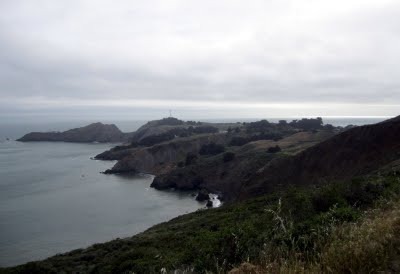
Point Bonita in the Marin Headlands, location of the finish line of the Miwok 100k, as seen from mile 61 of the course. For obvious reasons, I was more than a little happy to finally see it. Stay tuned for the full race report this week.
Get updates as soon as they're posted! Click here to subscribe to Running and Rambling.
Check out the Running Life book for a collection of our most popular columns.

The winner of Marshall Ulrich's Running on Empty book is Dan from Morgan Hill. The winner of the Merrell Barefoot women's Pace Glove trail shoes is Ellen Holly. Congrats to both of you, and be sure to e-mail me your address so I can pass it along to the right people.
To everybody else: thanks very much for entering, and you can find the Merrell Pace Glove in stock at TravelCountry.com, and Marshall's book at Amazon.com in traditional book or Kindle format.
*
This week's Random Shot of Beauty comes from the aforementioned run around Marin County:

Point Bonita in the Marin Headlands, location of the finish line of the Miwok 100k, as seen from mile 61 of the course. For obvious reasons, I was more than a little happy to finally see it. Stay tuned for the full race report this week.
Get updates as soon as they're posted! Click here to subscribe to Running and Rambling.
Check out the Running Life book for a collection of our most popular columns.

Published on May 08, 2011 12:35
May 5, 2011
CamelBak Skeeter Children's Pack Review
A quick reminder about two contests that will be wrapping up soon: one for a pair of Merrell Pace Glove women's trail shoes, and the other for a copy of Marshall Ulrich's great new book. No, they're not prizes of equal value … but they're both pretty cool. Winners will be announced on Sunday.
**
Strange as it sounds, one of the main factors in determining whether our kids would be up for hiking in Yosemite was hydration packs. More specifically, we wanted to know if they'd be able to carry their own water.
Prior to this spring, whenever we did family hikes, I would typically carry my own hydration pack as well as a couple of water bottles for everyone to share – but I knew that the prospect of lugging enough fluid for three kids to spend a whole day on the trails and steep hills of Yosemite was more than I wanted to deal with. In other words, Daddy wasn't playing the family camel anymore; sometimes you just have to draw a line.
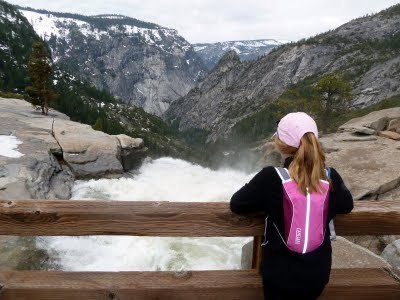
CamelBak Skeeter pack above Nevada Fall
For my 12-year-old son, this wasn't much of a problem, as he's tall enough to use a standard hydration pack, and was already accustomed to using it for day hikes and bike rides. My younger daughters were more of a problem, however; even the smallest adult packs seemed either too wide through the shoulders or too long through the holsters or trunk to be worn comfortably for an extended period of time. That's why I was relieved to find CamelBak's Skeeter pack, which is specifically designed for kids, and which my 9-year-old daughter has used extensively, including our Yosemite trip where most of the photos in this post were taken.

On the Mist Trail, with Illouette Fall in background
The Skeeter serves one very simple function: it holds a fluid compartment against your back. It doesn't have pockets or cargo containers or media cord outlets or anything remotely fancy (except for a reflective stripe, if you consider that fancy). However, it incorporates some of CamelBak's best innovations, and like all of the company's products, it comes with a lifetime guarantee for durability. It's also extremely lightweight and low profile – weighing just 3.8 oz (110g) without fluid, with an 11-inch torso length - so it rides very easily and is perfectly sized for smaller bodies.
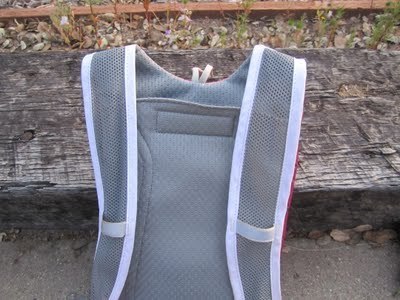
Lightweight mesh harness, comfort mesh back panel, Velcro reservoir pocket closure
Comfort is further enhanced by a super-lightweight mesh harness system, and a back panel with the same diamond mesh that CamelBak uses on its adult packs. The drink tube can be routed through a cross-strap on one side, with the bite valve tucked into the opposite side. The shoulder straps have an internal tunnel for the drink tube, and a Velcro fastener to close the reservoir compartment.
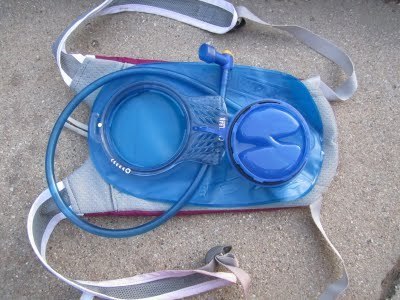
The Skeeter comes with CamelBak's new Antidote reservoir, which is a noticeable improvement over the Omega reservoirs that were already pretty darn awesome. It has a wide mouth opening with a new quarter-turn fastening system that locks the cap in place without any doubt about security. Using two Omega reservoirs and one Antidote on our trip, it was easy to tell a difference in the ease of closing the new version compared to the former. Fluid capacity on this pack is 50oz (1.5L), or roughly three-quarters the capacity of standard adult hydration packs.

At the edge of Vernal Fall
All the other traditional CamelBak reservoir features are here, too: the Big Bite valve with lockout lever, HydroGuard technology to prevent microbial buildup on the interior surfaces, and a PureFlow tube for a steady volume of fluid with each drink. When the pack is filled, it sits very securely against the back, with very minimal bouncing when running or jumping from rock to rock.

Rockhopping on the Yosemite Falls Trail
Both my daughter and I are quite impressed with the Skeeter pack, and after comparing the utility of adult packs and childrens packs over multiple outings, I'd say there's definitely a benefit to using child-specific gear. Truthfully, the only downside is that your kid will eventually grow out of it, but since the Skeeter pack is very affordably priced, you'll definitely get your money's worth if you use it for a reasonable amount of time.
CamelBak's Skeeter pack retails for $26 from Amazon.com as well as other online vendors.
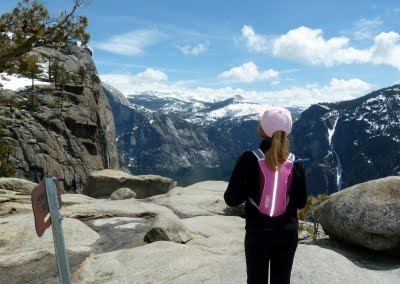
Above the Yosemite falls overlook
*Product provided by CamelBak
**See other product reviews on sidebar at right. If you have a product you'd like reviewed, contact me at info@runningandrambling.com.
Get updates as soon as they're posted! Click here to subscribe to Running and Rambling.
Check out the Running Life book for a collection of our most popular columns.

**
Strange as it sounds, one of the main factors in determining whether our kids would be up for hiking in Yosemite was hydration packs. More specifically, we wanted to know if they'd be able to carry their own water.
Prior to this spring, whenever we did family hikes, I would typically carry my own hydration pack as well as a couple of water bottles for everyone to share – but I knew that the prospect of lugging enough fluid for three kids to spend a whole day on the trails and steep hills of Yosemite was more than I wanted to deal with. In other words, Daddy wasn't playing the family camel anymore; sometimes you just have to draw a line.

CamelBak Skeeter pack above Nevada Fall
For my 12-year-old son, this wasn't much of a problem, as he's tall enough to use a standard hydration pack, and was already accustomed to using it for day hikes and bike rides. My younger daughters were more of a problem, however; even the smallest adult packs seemed either too wide through the shoulders or too long through the holsters or trunk to be worn comfortably for an extended period of time. That's why I was relieved to find CamelBak's Skeeter pack, which is specifically designed for kids, and which my 9-year-old daughter has used extensively, including our Yosemite trip where most of the photos in this post were taken.

On the Mist Trail, with Illouette Fall in background
The Skeeter serves one very simple function: it holds a fluid compartment against your back. It doesn't have pockets or cargo containers or media cord outlets or anything remotely fancy (except for a reflective stripe, if you consider that fancy). However, it incorporates some of CamelBak's best innovations, and like all of the company's products, it comes with a lifetime guarantee for durability. It's also extremely lightweight and low profile – weighing just 3.8 oz (110g) without fluid, with an 11-inch torso length - so it rides very easily and is perfectly sized for smaller bodies.

Lightweight mesh harness, comfort mesh back panel, Velcro reservoir pocket closure
Comfort is further enhanced by a super-lightweight mesh harness system, and a back panel with the same diamond mesh that CamelBak uses on its adult packs. The drink tube can be routed through a cross-strap on one side, with the bite valve tucked into the opposite side. The shoulder straps have an internal tunnel for the drink tube, and a Velcro fastener to close the reservoir compartment.

The Skeeter comes with CamelBak's new Antidote reservoir, which is a noticeable improvement over the Omega reservoirs that were already pretty darn awesome. It has a wide mouth opening with a new quarter-turn fastening system that locks the cap in place without any doubt about security. Using two Omega reservoirs and one Antidote on our trip, it was easy to tell a difference in the ease of closing the new version compared to the former. Fluid capacity on this pack is 50oz (1.5L), or roughly three-quarters the capacity of standard adult hydration packs.

At the edge of Vernal Fall
All the other traditional CamelBak reservoir features are here, too: the Big Bite valve with lockout lever, HydroGuard technology to prevent microbial buildup on the interior surfaces, and a PureFlow tube for a steady volume of fluid with each drink. When the pack is filled, it sits very securely against the back, with very minimal bouncing when running or jumping from rock to rock.

Rockhopping on the Yosemite Falls Trail
Both my daughter and I are quite impressed with the Skeeter pack, and after comparing the utility of adult packs and childrens packs over multiple outings, I'd say there's definitely a benefit to using child-specific gear. Truthfully, the only downside is that your kid will eventually grow out of it, but since the Skeeter pack is very affordably priced, you'll definitely get your money's worth if you use it for a reasonable amount of time.
CamelBak's Skeeter pack retails for $26 from Amazon.com as well as other online vendors.

Above the Yosemite falls overlook
*Product provided by CamelBak
**See other product reviews on sidebar at right. If you have a product you'd like reviewed, contact me at info@runningandrambling.com.
Get updates as soon as they're posted! Click here to subscribe to Running and Rambling.
Check out the Running Life book for a collection of our most popular columns.

Published on May 05, 2011 22:00
May 3, 2011
Running on Empty: Book Review, Video Trailer, and Giveaway
One of the most common descriptions you'll hear about Marshall Ulrich is how humble he is – and before I even started reading his book this spring, I had two examples of exactly what those people are talking about.
The first one occurred after Marshall happened to send me an unsolicited e-mail in response to a recent Monterey Herald column my friend Mike and I wrote about Marshall's one-time running companion Charlie Engle. Marshall told us he enjoyed reading the article, and informed us that he had a book coming out describing his misadventures with Charlie while running across America, and said he'd be happy to give us a copy to read.
 That's not such an unusual proposal … except for the fact that I already had Marshall's book, Running on Empty, in my possession, thanks to his professional publicist. It was almost as if he wasn't aware that he was a celebrity – even before the book was released, Marshall was one of the most widely respected ultrarunners in the world - and was trying to share his story by making connections with one reader at a time. When I told him that I was already working with his publicist, his response was something like, "Oh, OK … great to hear that you have a copy. Thanks for taking the time to review it."
That's not such an unusual proposal … except for the fact that I already had Marshall's book, Running on Empty, in my possession, thanks to his professional publicist. It was almost as if he wasn't aware that he was a celebrity – even before the book was released, Marshall was one of the most widely respected ultrarunners in the world - and was trying to share his story by making connections with one reader at a time. When I told him that I was already working with his publicist, his response was something like, "Oh, OK … great to hear that you have a copy. Thanks for taking the time to review it."
The second example of Marshall's humility was an e-mail exchange between him, Mike, and me as we peppered him with a few questions about his running experiences. When Mike asked him why he hadn't written a book before now, this was part of Marshall's reply:
The reason I didn't write a book sooner is that I didn't feel qualified. I didn't want anyone saying, "Marshall who? He has done what?" I wanted to have walked the walk.
For the record, here are portions of the resume that Marshall Ulrich felt left him unqualified to write about his experiences: 9-time Eco-Challenge competitor, finisher of over 100 footraces of 100 miles or more, 4-time winner of the Badwater Ultramarathon (in the old days, on the 146-mile course that went to the summit of Mount Whitney), only person to do a self-supported quadruple Badwater run, only person to do the Leadville 100 and Pikes Peak Marathon on the same weekend, and climbing all Seven Summits. You know … the stuff anyone can do.
Indeed, all of those accomplishments serve as a warm-up act to the main narrative of Running on Empty, which is an account of Marshall's transcontinental run that he completed in the fall of 2008, and was the subject of the feature-length documentary Running America (linked and previewed below). Marshall breezes through the first couple of chapters talking about his upbringing, the tragic loss of his first wife, and his early endurance sport exploits, then spends the rest of the book detailing his two-month odyssey from San Francisco to New York, which he also decided should be an attempt to take down the world record for the fastest crossing of the United States on foot. The previous record was set by 28-year-old Frank Giannino, and had stood since 1980; at the time of his own attempt, Marshall Ulrich was 57 years old. He defies age barriers just like any other obstacle, overcoming them mainly through sheer willpower and determination.
I won't spoil the ending of whether he set the record or not, because the run is really just the backdrop for many other issues that Marshall explores while on the road across America – and those, as much as the athletic endeavor, are the true appeal of Running on Empty. Marshall is one of those people who runs as a means of escape, both from personal demons and from soul-crushing external circumstances. He discusses what drives an extreme athlete to persevere no matter how daunting the next challenge might be – and how that single-mindedness often comes at the expense of career, relationships, and even family bonds.
One other point stands out about our e-mail exchange with Marshall: he told us that in hindsight, he's glad that he waited so long to write a book. He said that his perspective and priorities have changed since his younger days, and that he wouldn't have been capable of acknowledging his own shortcomings or developing any meaningful insight if he had tried telling his story sooner. In that regard, it's a great thing that he waited, because Running on Empty is equal parts heartfelt personal journey and wonderful adventure tale. You'll identify with him on the personal stuff, and admire him for the athletic feats.
Running on Empty is available for $17.16 from Amazon.com, or $12.99 for the Kindle version. I've also been given an extra book to offer as a giveaway prize, so one of my readers will receive a free copy; leave a comment below this post to enter, and I'll announce the winner on Sunday, May 8.
Thanks very much to TLC book tours for setting up this review and providing a copy to give away.
**
As a special bonus, here's a great video clip of Marshall's run across the USA, excerpted from the film Running America:
Get updates as soon as they're posted! Click here to subscribe to Running and Rambling.
Check out the Running Life book for a collection of our most popular columns.

The first one occurred after Marshall happened to send me an unsolicited e-mail in response to a recent Monterey Herald column my friend Mike and I wrote about Marshall's one-time running companion Charlie Engle. Marshall told us he enjoyed reading the article, and informed us that he had a book coming out describing his misadventures with Charlie while running across America, and said he'd be happy to give us a copy to read.
 That's not such an unusual proposal … except for the fact that I already had Marshall's book, Running on Empty, in my possession, thanks to his professional publicist. It was almost as if he wasn't aware that he was a celebrity – even before the book was released, Marshall was one of the most widely respected ultrarunners in the world - and was trying to share his story by making connections with one reader at a time. When I told him that I was already working with his publicist, his response was something like, "Oh, OK … great to hear that you have a copy. Thanks for taking the time to review it."
That's not such an unusual proposal … except for the fact that I already had Marshall's book, Running on Empty, in my possession, thanks to his professional publicist. It was almost as if he wasn't aware that he was a celebrity – even before the book was released, Marshall was one of the most widely respected ultrarunners in the world - and was trying to share his story by making connections with one reader at a time. When I told him that I was already working with his publicist, his response was something like, "Oh, OK … great to hear that you have a copy. Thanks for taking the time to review it."The second example of Marshall's humility was an e-mail exchange between him, Mike, and me as we peppered him with a few questions about his running experiences. When Mike asked him why he hadn't written a book before now, this was part of Marshall's reply:
The reason I didn't write a book sooner is that I didn't feel qualified. I didn't want anyone saying, "Marshall who? He has done what?" I wanted to have walked the walk.
For the record, here are portions of the resume that Marshall Ulrich felt left him unqualified to write about his experiences: 9-time Eco-Challenge competitor, finisher of over 100 footraces of 100 miles or more, 4-time winner of the Badwater Ultramarathon (in the old days, on the 146-mile course that went to the summit of Mount Whitney), only person to do a self-supported quadruple Badwater run, only person to do the Leadville 100 and Pikes Peak Marathon on the same weekend, and climbing all Seven Summits. You know … the stuff anyone can do.
Indeed, all of those accomplishments serve as a warm-up act to the main narrative of Running on Empty, which is an account of Marshall's transcontinental run that he completed in the fall of 2008, and was the subject of the feature-length documentary Running America (linked and previewed below). Marshall breezes through the first couple of chapters talking about his upbringing, the tragic loss of his first wife, and his early endurance sport exploits, then spends the rest of the book detailing his two-month odyssey from San Francisco to New York, which he also decided should be an attempt to take down the world record for the fastest crossing of the United States on foot. The previous record was set by 28-year-old Frank Giannino, and had stood since 1980; at the time of his own attempt, Marshall Ulrich was 57 years old. He defies age barriers just like any other obstacle, overcoming them mainly through sheer willpower and determination.
I won't spoil the ending of whether he set the record or not, because the run is really just the backdrop for many other issues that Marshall explores while on the road across America – and those, as much as the athletic endeavor, are the true appeal of Running on Empty. Marshall is one of those people who runs as a means of escape, both from personal demons and from soul-crushing external circumstances. He discusses what drives an extreme athlete to persevere no matter how daunting the next challenge might be – and how that single-mindedness often comes at the expense of career, relationships, and even family bonds.
One other point stands out about our e-mail exchange with Marshall: he told us that in hindsight, he's glad that he waited so long to write a book. He said that his perspective and priorities have changed since his younger days, and that he wouldn't have been capable of acknowledging his own shortcomings or developing any meaningful insight if he had tried telling his story sooner. In that regard, it's a great thing that he waited, because Running on Empty is equal parts heartfelt personal journey and wonderful adventure tale. You'll identify with him on the personal stuff, and admire him for the athletic feats.
Running on Empty is available for $17.16 from Amazon.com, or $12.99 for the Kindle version. I've also been given an extra book to offer as a giveaway prize, so one of my readers will receive a free copy; leave a comment below this post to enter, and I'll announce the winner on Sunday, May 8.
Thanks very much to TLC book tours for setting up this review and providing a copy to give away.
**
As a special bonus, here's a great video clip of Marshall's run across the USA, excerpted from the film Running America:
Get updates as soon as they're posted! Click here to subscribe to Running and Rambling.
Check out the Running Life book for a collection of our most popular columns.

Published on May 03, 2011 21:14
May 1, 2011
Lessons From a 9-Year-Old: Big Sur 5K Race Report
The nice thing about running a 5K rather than a longer endurance event is that instead of spending several hours on the course, you're only in the arena for a half-hour or so. In other words, it's not a compete day-killer – and even when you account for gnoshing post-race food and shooting the breeze with friends and co-runners, you've still got plenty of time to get home and relax for a bit before plunking out a race report.
Which is why I'm able to report on the weekend's running event in such timely fashion: instead of participating in the Wildflower Triathlon, Quicksilver 50M, or Big Sur Marathon – all of which took place this weekend, and are all fantastic races that I've done in the past (see links) and would love to do again at some point – I returned with my daughter to the Big Sur 5K, which last year was the scene of her first-ever road race.
I wrote about that run last year, and this year's version wasn't dramatically different, so I'm not exactly compelled to do another traditional report that could potentially read like a carbon copy from 12 months ago. However, there were enough memorable points that I thought it might be fun to throw together some snapshots, observations, and perhaps a few tidbits of advice to share.
Accordingly, allow me to present some scenes from the Big Sur 5K:
 It always amazes me how mellow 5K runners are in comparison to marathon runners. You know how at the start of most marathons, the announcer always has to tell the runners to stay behind the start line? True story: about 30 seconds before our race, a race crew member had to get on the loudspeaker and tell everyone to move up about 20 yards so they would be at the official line when the gun went off. It's like a Bizarro world for a seasoned marathoner.
It always amazes me how mellow 5K runners are in comparison to marathon runners. You know how at the start of most marathons, the announcer always has to tell the runners to stay behind the start line? True story: about 30 seconds before our race, a race crew member had to get on the loudspeaker and tell everyone to move up about 20 yards so they would be at the official line when the gun went off. It's like a Bizarro world for a seasoned marathoner.
 Footwear for the day consisted of the Vibram Bikila LS for me, which will be formally reviewed here in the next week or two. As for my daughter … I'm going to hold off just a bit for now, because I'm still kicking around a post about minimalist footwear for kids that I hope to have wrapped up soon. A trained eye can probably figure it out, though.
Footwear for the day consisted of the Vibram Bikila LS for me, which will be formally reviewed here in the next week or two. As for my daughter … I'm going to hold off just a bit for now, because I'm still kicking around a post about minimalist footwear for kids that I hope to have wrapped up soon. A trained eye can probably figure it out, though.
And speaking of shoes …
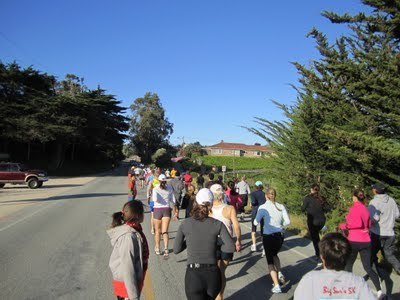 Here's one practical tip, courtesy of my 9-year-old daughter, who is the tiny blond head next to the girl in short shorts in the above photo: if you're going to give a great effort on a sizeable hill in the first mile of the race to clear some space for yourself away from the walking crowd, make sure your right shoe is laced securely as you're doing it …
Here's one practical tip, courtesy of my 9-year-old daughter, who is the tiny blond head next to the girl in short shorts in the above photo: if you're going to give a great effort on a sizeable hill in the first mile of the race to clear some space for yourself away from the walking crowd, make sure your right shoe is laced securely as you're doing it …
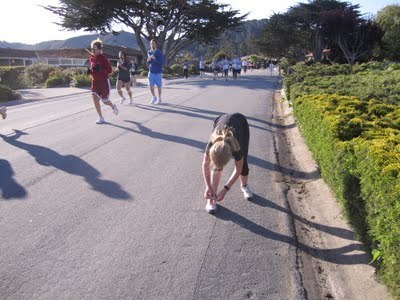 … otherwise you might have to give back a lot of that time when you finally make it to the top and realize that it's untied.
… otherwise you might have to give back a lot of that time when you finally make it to the top and realize that it's untied.
 Another tip for 9-year-olds: just because you're small and cute, don't think that earns you any special privileges on the race course. See my daughter in the black shirt? About a half-second after this photo was taken, the grown-up dude next to her totally swerved into her to cut the corner a little more closely … you know, so he could bust a 10:48 mile split instead of a 10:49.
Another tip for 9-year-olds: just because you're small and cute, don't think that earns you any special privileges on the race course. See my daughter in the black shirt? About a half-second after this photo was taken, the grown-up dude next to her totally swerved into her to cut the corner a little more closely … you know, so he could bust a 10:48 mile split instead of a 10:49.
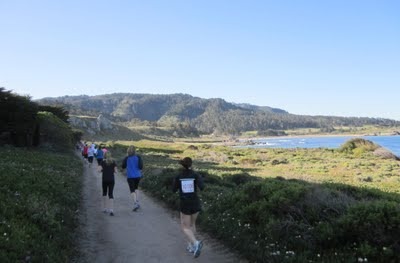 More from the "adults acting like idiots" department: one of the people in this photo – I won't specify who - made a point of telling everybody "We're running in front of Brad Pitt's house right now!" She was referring to the row of houses on the left side of this path, while the rest of us – or maybe I should just speak for my daughter and me – could care less about our proximity to a material possession of a Hollywood celebrity …
More from the "adults acting like idiots" department: one of the people in this photo – I won't specify who - made a point of telling everybody "We're running in front of Brad Pitt's house right now!" She was referring to the row of houses on the left side of this path, while the rest of us – or maybe I should just speak for my daughter and me – could care less about our proximity to a material possession of a Hollywood celebrity …
 … because we were much more attentive to and appreciative of the beautiful, natural ocean views on our right. But again, maybe that's just my daughter and me.
… because we were much more attentive to and appreciative of the beautiful, natural ocean views on our right. But again, maybe that's just my daughter and me.
 Two thoughts stand out here: 1) I often tell my daughter that with her long legs and knock-kneed stride, she reminds me of a baby giraffe sometimes. I'm thinking that if she ever expresses disbelief, I'll use this photo as Exhibit A. Also …
Two thoughts stand out here: 1) I often tell my daughter that with her long legs and knock-kneed stride, she reminds me of a baby giraffe sometimes. I'm thinking that if she ever expresses disbelief, I'll use this photo as Exhibit A. Also …
2) One more practical tip from my daughter: if you're going to give a great effort on a sizeable hill in the last mile of the race to start reeling in some people who went out too fast, make sure your left shoe is laced tightly as well …
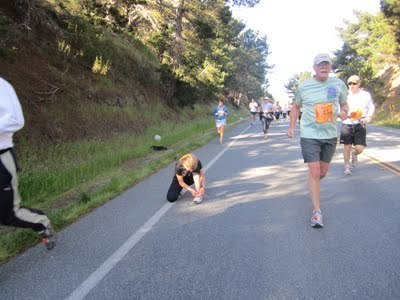 … otherwise … yeah. Kind of a bummer.
… otherwise … yeah. Kind of a bummer.
 One final tip: if you're trying to break your course time from the previous year and you end up giving away about a minute or so in shoe-tying predicaments, you'd better high-tail it during the last half-mile to make up some ground. To my daughter's credit, that's exactly what she did …
One final tip: if you're trying to break your course time from the previous year and you end up giving away about a minute or so in shoe-tying predicaments, you'd better high-tail it during the last half-mile to make up some ground. To my daughter's credit, that's exactly what she did …
 … and sailed into the finish area a full two minutes faster than the year before. She even managed to win an age group award, which was a nice bonus. Now when the marathoners win age group awards at Big Sur, the prize includes a bottle of Monterey County wine; but for some reason, the killjoys on the race committee decided that the winners of the 5K's 8-11 age group aren't entitled to a similar prize. Whatever.
… and sailed into the finish area a full two minutes faster than the year before. She even managed to win an age group award, which was a nice bonus. Now when the marathoners win age group awards at Big Sur, the prize includes a bottle of Monterey County wine; but for some reason, the killjoys on the race committee decided that the winners of the 5K's 8-11 age group aren't entitled to a similar prize. Whatever.
 Even without the alcohol, it was a pretty sweet morning all the way around – which is pretty much what you expect when it comes to Big Sur events. My daughter and I both went home with happy feet, glad to have spent another fun race morning together, and talking about similar future mornings to come.
Even without the alcohol, it was a pretty sweet morning all the way around – which is pretty much what you expect when it comes to Big Sur events. My daughter and I both went home with happy feet, glad to have spent another fun race morning together, and talking about similar future mornings to come.
*See other race reports under tab at top of page
Get updates as soon as they're posted! Click here to subscribe to Running and Rambling.
Check out the Running Life book for a collection of our most popular columns.

Which is why I'm able to report on the weekend's running event in such timely fashion: instead of participating in the Wildflower Triathlon, Quicksilver 50M, or Big Sur Marathon – all of which took place this weekend, and are all fantastic races that I've done in the past (see links) and would love to do again at some point – I returned with my daughter to the Big Sur 5K, which last year was the scene of her first-ever road race.
I wrote about that run last year, and this year's version wasn't dramatically different, so I'm not exactly compelled to do another traditional report that could potentially read like a carbon copy from 12 months ago. However, there were enough memorable points that I thought it might be fun to throw together some snapshots, observations, and perhaps a few tidbits of advice to share.
Accordingly, allow me to present some scenes from the Big Sur 5K:
 It always amazes me how mellow 5K runners are in comparison to marathon runners. You know how at the start of most marathons, the announcer always has to tell the runners to stay behind the start line? True story: about 30 seconds before our race, a race crew member had to get on the loudspeaker and tell everyone to move up about 20 yards so they would be at the official line when the gun went off. It's like a Bizarro world for a seasoned marathoner.
It always amazes me how mellow 5K runners are in comparison to marathon runners. You know how at the start of most marathons, the announcer always has to tell the runners to stay behind the start line? True story: about 30 seconds before our race, a race crew member had to get on the loudspeaker and tell everyone to move up about 20 yards so they would be at the official line when the gun went off. It's like a Bizarro world for a seasoned marathoner. Footwear for the day consisted of the Vibram Bikila LS for me, which will be formally reviewed here in the next week or two. As for my daughter … I'm going to hold off just a bit for now, because I'm still kicking around a post about minimalist footwear for kids that I hope to have wrapped up soon. A trained eye can probably figure it out, though.
Footwear for the day consisted of the Vibram Bikila LS for me, which will be formally reviewed here in the next week or two. As for my daughter … I'm going to hold off just a bit for now, because I'm still kicking around a post about minimalist footwear for kids that I hope to have wrapped up soon. A trained eye can probably figure it out, though. And speaking of shoes …
 Here's one practical tip, courtesy of my 9-year-old daughter, who is the tiny blond head next to the girl in short shorts in the above photo: if you're going to give a great effort on a sizeable hill in the first mile of the race to clear some space for yourself away from the walking crowd, make sure your right shoe is laced securely as you're doing it …
Here's one practical tip, courtesy of my 9-year-old daughter, who is the tiny blond head next to the girl in short shorts in the above photo: if you're going to give a great effort on a sizeable hill in the first mile of the race to clear some space for yourself away from the walking crowd, make sure your right shoe is laced securely as you're doing it … … otherwise you might have to give back a lot of that time when you finally make it to the top and realize that it's untied.
… otherwise you might have to give back a lot of that time when you finally make it to the top and realize that it's untied.  Another tip for 9-year-olds: just because you're small and cute, don't think that earns you any special privileges on the race course. See my daughter in the black shirt? About a half-second after this photo was taken, the grown-up dude next to her totally swerved into her to cut the corner a little more closely … you know, so he could bust a 10:48 mile split instead of a 10:49.
Another tip for 9-year-olds: just because you're small and cute, don't think that earns you any special privileges on the race course. See my daughter in the black shirt? About a half-second after this photo was taken, the grown-up dude next to her totally swerved into her to cut the corner a little more closely … you know, so he could bust a 10:48 mile split instead of a 10:49. More from the "adults acting like idiots" department: one of the people in this photo – I won't specify who - made a point of telling everybody "We're running in front of Brad Pitt's house right now!" She was referring to the row of houses on the left side of this path, while the rest of us – or maybe I should just speak for my daughter and me – could care less about our proximity to a material possession of a Hollywood celebrity …
More from the "adults acting like idiots" department: one of the people in this photo – I won't specify who - made a point of telling everybody "We're running in front of Brad Pitt's house right now!" She was referring to the row of houses on the left side of this path, while the rest of us – or maybe I should just speak for my daughter and me – could care less about our proximity to a material possession of a Hollywood celebrity … … because we were much more attentive to and appreciative of the beautiful, natural ocean views on our right. But again, maybe that's just my daughter and me.
… because we were much more attentive to and appreciative of the beautiful, natural ocean views on our right. But again, maybe that's just my daughter and me. Two thoughts stand out here: 1) I often tell my daughter that with her long legs and knock-kneed stride, she reminds me of a baby giraffe sometimes. I'm thinking that if she ever expresses disbelief, I'll use this photo as Exhibit A. Also …
Two thoughts stand out here: 1) I often tell my daughter that with her long legs and knock-kneed stride, she reminds me of a baby giraffe sometimes. I'm thinking that if she ever expresses disbelief, I'll use this photo as Exhibit A. Also … 2) One more practical tip from my daughter: if you're going to give a great effort on a sizeable hill in the last mile of the race to start reeling in some people who went out too fast, make sure your left shoe is laced tightly as well …
 … otherwise … yeah. Kind of a bummer.
… otherwise … yeah. Kind of a bummer.  One final tip: if you're trying to break your course time from the previous year and you end up giving away about a minute or so in shoe-tying predicaments, you'd better high-tail it during the last half-mile to make up some ground. To my daughter's credit, that's exactly what she did …
One final tip: if you're trying to break your course time from the previous year and you end up giving away about a minute or so in shoe-tying predicaments, you'd better high-tail it during the last half-mile to make up some ground. To my daughter's credit, that's exactly what she did … … and sailed into the finish area a full two minutes faster than the year before. She even managed to win an age group award, which was a nice bonus. Now when the marathoners win age group awards at Big Sur, the prize includes a bottle of Monterey County wine; but for some reason, the killjoys on the race committee decided that the winners of the 5K's 8-11 age group aren't entitled to a similar prize. Whatever.
… and sailed into the finish area a full two minutes faster than the year before. She even managed to win an age group award, which was a nice bonus. Now when the marathoners win age group awards at Big Sur, the prize includes a bottle of Monterey County wine; but for some reason, the killjoys on the race committee decided that the winners of the 5K's 8-11 age group aren't entitled to a similar prize. Whatever. Even without the alcohol, it was a pretty sweet morning all the way around – which is pretty much what you expect when it comes to Big Sur events. My daughter and I both went home with happy feet, glad to have spent another fun race morning together, and talking about similar future mornings to come.
Even without the alcohol, it was a pretty sweet morning all the way around – which is pretty much what you expect when it comes to Big Sur events. My daughter and I both went home with happy feet, glad to have spent another fun race morning together, and talking about similar future mornings to come.*See other race reports under tab at top of page
Get updates as soon as they're posted! Click here to subscribe to Running and Rambling.
Check out the Running Life book for a collection of our most popular columns.

Published on May 01, 2011 21:29
April 30, 2011
Running Life Book Discount; Random Shots of Beauty
Two brief reminders before this weekend's RSOB ...
1) If for some reason you missed it, be sure to sign up for a chance to win a pair of Merrell Barefoot Women's Pace Glove trail shoes; the winner will be announced here next Sunday.
2) You've got one more day to purchase my Running Life book at the 20% discounted price from our website, in conjunction with our promotion at the Big Sur Marathon race expo. The discount is good through close of business on Sunday, May 1.
*
Speaking of the Big Sur Marathon, that's the subject of our Random Shot of Beauty:

View of the beautiful, rugged Pacific coastline from Highway 1 in the Carmel Highlands, an equally beautiful and rugged stretch of road that this year's marathoners get to traverse twice. Lucky them.
As for me, I won't be in the marathon this year - I'll be doing this again instead. Honestly, I wouldn't have it any other way.
Get updates as soon as they're posted! Click here to subscribe to Running and Rambling.
Check out the Running Life book for a collection of our most popular columns.

1) If for some reason you missed it, be sure to sign up for a chance to win a pair of Merrell Barefoot Women's Pace Glove trail shoes; the winner will be announced here next Sunday.
2) You've got one more day to purchase my Running Life book at the 20% discounted price from our website, in conjunction with our promotion at the Big Sur Marathon race expo. The discount is good through close of business on Sunday, May 1.
*
Speaking of the Big Sur Marathon, that's the subject of our Random Shot of Beauty:

View of the beautiful, rugged Pacific coastline from Highway 1 in the Carmel Highlands, an equally beautiful and rugged stretch of road that this year's marathoners get to traverse twice. Lucky them.
As for me, I won't be in the marathon this year - I'll be doing this again instead. Honestly, I wouldn't have it any other way.
Get updates as soon as they're posted! Click here to subscribe to Running and Rambling.
Check out the Running Life book for a collection of our most popular columns.

Published on April 30, 2011 20:17
April 28, 2011
Merrell Barefoot Women's Pace Glove Review and Giveaway
Obviously, the big news with today's post is that it features a giveaway of another sweet Merrell shoe. This time around, it's the Merrell Barefoot Pace Glove, a model that my wife has been testing for a couple of months, and one that the company introduced last year as "designed specifically for women, by women." So there's definitely a strong Girl Power vibe around the website today; maybe this finally makes up for all those Britney Spears, Beyonce and Shakira photos I used to post here all the time back in the old days. (OK, maybe not … but it's a start.)
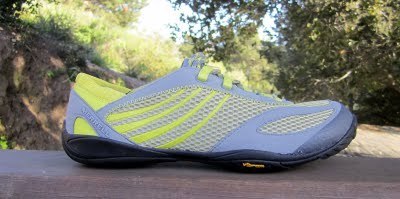 Merrell Barefoot Pace Glove
Merrell Barefoot Pace Glove
The Pace Glove is one of three models in Merrell's barefoot collection for women, and is the one best suited for trail running, making it the female equivalent to the men's Trail Glove that I reviewed earlier this month. In fact, it's so similar to the Trail Glove that I initially questioned what exactly the distinctions are that make the Pace Glove a more female-oriented shoe.
That's not meant as a knock; the Trail Glove is an outstanding shoe, and the Pace Glove is equally remarkable. It's just that when comparing the two models, there's not a whole lot to distinguish the male from the female of the species. At 4.7 ounces, the Pace Glove is a bit lighter than the 6.2-oz Trail Glove – not unlike women and men in general, right? - but its overall structure and performance features are otherwise nearly equivalent.
 Like the Trail Glove, the Pace Glove has an upper constructed of microfiber and breathable air mesh, which provides nice ventilation while still keeping the foot well-insulated in cold conditions (especially with socks) when necessary. Rubber toe bumpers in front improve the upper's durability and offer protection in case of toe-stubbing.
Like the Trail Glove, the Pace Glove has an upper constructed of microfiber and breathable air mesh, which provides nice ventilation while still keeping the foot well-insulated in cold conditions (especially with socks) when necessary. Rubber toe bumpers in front improve the upper's durability and offer protection in case of toe-stubbing.
 Merrell's Omni-fit lacing system, along with vertical TPU overlays hooked into the laces, wraps the entire midfoot to make the shoe fit like a glove (thus the name, I suppose). It has the same synthetic leather rearfoot sling to stabilize the ankle, and a grippy microfiber footbed that prevents your foot from sliding around on top of the midsole.
Merrell's Omni-fit lacing system, along with vertical TPU overlays hooked into the laces, wraps the entire midfoot to make the shoe fit like a glove (thus the name, I suppose). It has the same synthetic leather rearfoot sling to stabilize the ankle, and a grippy microfiber footbed that prevents your foot from sliding around on top of the midsole.
Since all of these features are also present on the Trail Glove, and since one of my observations about that model was how the snug fit caused slight difficulty getting my foot into the shoe, I specifically asked my wife about this (more than once, actually). She reported no difficulty getting the shoes on, and she wears socks with them every day. This might reflect the relative narrowness of women's feet compared to men's – or maybe it just indicates that I have fat feet; we're only an experiment of two. At any rate, she reported that the Pace Gloves are extremely comfortable, even when wearing them for several hours.
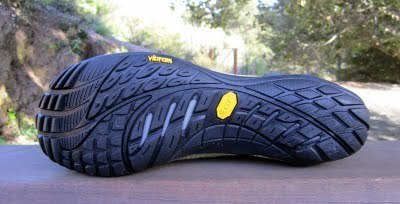 Turned upside down, you can't tell a difference between the male and female shoes; they both utilize the identical Vibram TC-1 rubber outsole that provides great traction in nearly all trail conditions, and has proven to be extremely durable after hundreds of trail miles (my model) and approximately 100 mixed road and trail miles (my wife's). I had a couple of small quibbles with this outsole in my Trail Glove review, but I have to say that I'm very impressed by how the lugs have retained their thickness even after extensive use.
Turned upside down, you can't tell a difference between the male and female shoes; they both utilize the identical Vibram TC-1 rubber outsole that provides great traction in nearly all trail conditions, and has proven to be extremely durable after hundreds of trail miles (my model) and approximately 100 mixed road and trail miles (my wife's). I had a couple of small quibbles with this outsole in my Trail Glove review, but I have to say that I'm very impressed by how the lugs have retained their thickness even after extensive use.
 Pace Glove on L, Trail Glove on R
Pace Glove on L, Trail Glove on R
Predictably, the best way to distinguish the male from the female is to look at the tail end. Instead of the thin ankle collar with pull-up thumb loop on the Trail Glove, the Pace Glove has a more lady-like foot sling that is stretchable but sits securely around the ankle once the shoe is in place. I suspect that the wrinkled fabric of this collar might be a source of mild discomfort with sockless runners, but since my wife isn't in that category, it posed no problems whatsoever for her.
 Close-up of heel sling; yellow TPU overlays attach to lace system
Close-up of heel sling; yellow TPU overlays attach to lace system
The same structure and technology that Merrell uses through the midsole and outsole of its men's barefoot models are present in the Pace Glove as well. It's built with a completely flexible, true zero-drop platform to promote the biomechanics of natural running. Total "off the ground" height of the Pace Glove is approximately 12mm in the heel and forefoot, combining the outsole thickness with a 4mm compression molded EVA midsole, 1mm shock absorption plate in the forefoot, and the thin insole footbed.
 Super-flexible midsole
Super-flexible midsole
The height of this shoe was probably the most interesting consideration for me in comparing my wife's performance feedback with my own. When I first wore my Merrells, the 12mm spec seemed relatively high – probably due to the fact that I've been running barefoot or using true minimalist footwear for the better part of two years – and the Trail Gloves at first seemed a little too cushiony to be truly minimalist. However, my wife typically uses thicker zero-drop shoes like GoLite's Micro Lite, and she could tell a big difference in reduced cushioning and increased ground feel once starting with the Pace Gloves. She even developed some soreness underneath her metatarsal heads after increasing her distance too quickly with the Merrells; while this wasn't a positive development for her, it was proof to me that this line of footwear really does approximate barefoot running quite effectively.
At this point, my wife doesn't want to go any thinner than her Pace Gloves, and I wouldn't want to go any thicker than my Trail Gloves; however, we both love wearing our respective Merrells. This was the genesis of the premise in my Trail Glove review that Merrell's Barefoot line is well-positioned to become the first mainstream barefoot shoe, equally attractive to dedicated minimalist users as well as recreational runners who want to go as light and low as possible without giving up modest comfort and protective features. Just as it did with the men's version, Merrell's women's Pace Glove should appeal to a broad spectrum of runners, and I anticipate it will become a lot of people's favorite shoe this year.
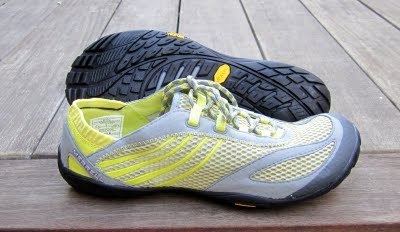
The Merrell Barefoot Pace Glove retails for $100 from TravelCountry.com – but for one lucky female reader, I'll spare you the trouble of buying a pair. So here's your chance, ladies: the giveaway contest for one pair of Pace Gloves is on.
We'll use the same contest rules as the other Merrell giveaway: one entry for a lone comment, plus one additional entry for a Facebook or Twitter link to this contest page, and a third for a blog link to this page. Men are welcome to enter and perhaps become a Sugar Daddy for their lucky gal. When you leave a comment below, tell me how many entries you've earned. The winner will be announced next Sunday, May 8th.
Good luck to everyone, and very big thanks to Merrell for sponsoring this giveaway!
*Product provided by Merrell
**See other product reviews on sidebar at right. If you have a product you'd like reviewed, contact me at info@runningandrambling.com.
Get updates as soon as they're posted! Click here to subscribe to Running and Rambling.
Check out the Running Life book for a collection of our most popular columns.

 Merrell Barefoot Pace Glove
Merrell Barefoot Pace GloveThe Pace Glove is one of three models in Merrell's barefoot collection for women, and is the one best suited for trail running, making it the female equivalent to the men's Trail Glove that I reviewed earlier this month. In fact, it's so similar to the Trail Glove that I initially questioned what exactly the distinctions are that make the Pace Glove a more female-oriented shoe.
That's not meant as a knock; the Trail Glove is an outstanding shoe, and the Pace Glove is equally remarkable. It's just that when comparing the two models, there's not a whole lot to distinguish the male from the female of the species. At 4.7 ounces, the Pace Glove is a bit lighter than the 6.2-oz Trail Glove – not unlike women and men in general, right? - but its overall structure and performance features are otherwise nearly equivalent.
 Like the Trail Glove, the Pace Glove has an upper constructed of microfiber and breathable air mesh, which provides nice ventilation while still keeping the foot well-insulated in cold conditions (especially with socks) when necessary. Rubber toe bumpers in front improve the upper's durability and offer protection in case of toe-stubbing.
Like the Trail Glove, the Pace Glove has an upper constructed of microfiber and breathable air mesh, which provides nice ventilation while still keeping the foot well-insulated in cold conditions (especially with socks) when necessary. Rubber toe bumpers in front improve the upper's durability and offer protection in case of toe-stubbing. Merrell's Omni-fit lacing system, along with vertical TPU overlays hooked into the laces, wraps the entire midfoot to make the shoe fit like a glove (thus the name, I suppose). It has the same synthetic leather rearfoot sling to stabilize the ankle, and a grippy microfiber footbed that prevents your foot from sliding around on top of the midsole.
Merrell's Omni-fit lacing system, along with vertical TPU overlays hooked into the laces, wraps the entire midfoot to make the shoe fit like a glove (thus the name, I suppose). It has the same synthetic leather rearfoot sling to stabilize the ankle, and a grippy microfiber footbed that prevents your foot from sliding around on top of the midsole.Since all of these features are also present on the Trail Glove, and since one of my observations about that model was how the snug fit caused slight difficulty getting my foot into the shoe, I specifically asked my wife about this (more than once, actually). She reported no difficulty getting the shoes on, and she wears socks with them every day. This might reflect the relative narrowness of women's feet compared to men's – or maybe it just indicates that I have fat feet; we're only an experiment of two. At any rate, she reported that the Pace Gloves are extremely comfortable, even when wearing them for several hours.
 Turned upside down, you can't tell a difference between the male and female shoes; they both utilize the identical Vibram TC-1 rubber outsole that provides great traction in nearly all trail conditions, and has proven to be extremely durable after hundreds of trail miles (my model) and approximately 100 mixed road and trail miles (my wife's). I had a couple of small quibbles with this outsole in my Trail Glove review, but I have to say that I'm very impressed by how the lugs have retained their thickness even after extensive use.
Turned upside down, you can't tell a difference between the male and female shoes; they both utilize the identical Vibram TC-1 rubber outsole that provides great traction in nearly all trail conditions, and has proven to be extremely durable after hundreds of trail miles (my model) and approximately 100 mixed road and trail miles (my wife's). I had a couple of small quibbles with this outsole in my Trail Glove review, but I have to say that I'm very impressed by how the lugs have retained their thickness even after extensive use. Pace Glove on L, Trail Glove on R
Pace Glove on L, Trail Glove on RPredictably, the best way to distinguish the male from the female is to look at the tail end. Instead of the thin ankle collar with pull-up thumb loop on the Trail Glove, the Pace Glove has a more lady-like foot sling that is stretchable but sits securely around the ankle once the shoe is in place. I suspect that the wrinkled fabric of this collar might be a source of mild discomfort with sockless runners, but since my wife isn't in that category, it posed no problems whatsoever for her.
 Close-up of heel sling; yellow TPU overlays attach to lace system
Close-up of heel sling; yellow TPU overlays attach to lace systemThe same structure and technology that Merrell uses through the midsole and outsole of its men's barefoot models are present in the Pace Glove as well. It's built with a completely flexible, true zero-drop platform to promote the biomechanics of natural running. Total "off the ground" height of the Pace Glove is approximately 12mm in the heel and forefoot, combining the outsole thickness with a 4mm compression molded EVA midsole, 1mm shock absorption plate in the forefoot, and the thin insole footbed.
 Super-flexible midsole
Super-flexible midsoleThe height of this shoe was probably the most interesting consideration for me in comparing my wife's performance feedback with my own. When I first wore my Merrells, the 12mm spec seemed relatively high – probably due to the fact that I've been running barefoot or using true minimalist footwear for the better part of two years – and the Trail Gloves at first seemed a little too cushiony to be truly minimalist. However, my wife typically uses thicker zero-drop shoes like GoLite's Micro Lite, and she could tell a big difference in reduced cushioning and increased ground feel once starting with the Pace Gloves. She even developed some soreness underneath her metatarsal heads after increasing her distance too quickly with the Merrells; while this wasn't a positive development for her, it was proof to me that this line of footwear really does approximate barefoot running quite effectively.
At this point, my wife doesn't want to go any thinner than her Pace Gloves, and I wouldn't want to go any thicker than my Trail Gloves; however, we both love wearing our respective Merrells. This was the genesis of the premise in my Trail Glove review that Merrell's Barefoot line is well-positioned to become the first mainstream barefoot shoe, equally attractive to dedicated minimalist users as well as recreational runners who want to go as light and low as possible without giving up modest comfort and protective features. Just as it did with the men's version, Merrell's women's Pace Glove should appeal to a broad spectrum of runners, and I anticipate it will become a lot of people's favorite shoe this year.

The Merrell Barefoot Pace Glove retails for $100 from TravelCountry.com – but for one lucky female reader, I'll spare you the trouble of buying a pair. So here's your chance, ladies: the giveaway contest for one pair of Pace Gloves is on.
We'll use the same contest rules as the other Merrell giveaway: one entry for a lone comment, plus one additional entry for a Facebook or Twitter link to this contest page, and a third for a blog link to this page. Men are welcome to enter and perhaps become a Sugar Daddy for their lucky gal. When you leave a comment below, tell me how many entries you've earned. The winner will be announced next Sunday, May 8th.
Good luck to everyone, and very big thanks to Merrell for sponsoring this giveaway!
*Product provided by Merrell
**See other product reviews on sidebar at right. If you have a product you'd like reviewed, contact me at info@runningandrambling.com.
Get updates as soon as they're posted! Click here to subscribe to Running and Rambling.
Check out the Running Life book for a collection of our most popular columns.

Published on April 28, 2011 18:49
April 26, 2011
Hiking Yosemite With Kids, Part 2: Yosemite Falls
If you were following Part 1 yesterday, you'll recall that my wife and I had just guided our three kids on a hike to the top of Nevada Fall and back, a 7-mile round trip with about 2000' of climbing, and an adventure which helped them fall in love with Yosemite the same way my wife and I each did on our first visits here.
We didn't tell the kids this at the time, but the Mist Trail was our "building confidence" hike – because we knew that the challenge of Day 2 would be significantly greater.
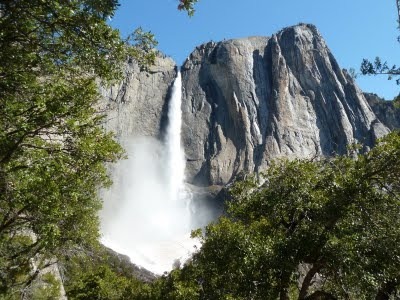 Our objective for the day was Yosemite Falls, which at roughly 4 miles from our starting point at Yosemite Lodge was only slightly longer than the previous day's outing, but has an additional 700' of climbing, much of it over very irregular rocky terrain. (I've also profiled this hike in a previous photo tour from two years ago.) If there are any city folk reading this who want a frame of reference, the hike is roughly the equivalent of climbing up two Empire State Buildings – except that instead of having an enclosed stairwell and railing to hold onto, the path on the top third of the climb is covered in snow, frequently gets slippery, and is less than 1 foot wide. Hopefully that helps.
Our objective for the day was Yosemite Falls, which at roughly 4 miles from our starting point at Yosemite Lodge was only slightly longer than the previous day's outing, but has an additional 700' of climbing, much of it over very irregular rocky terrain. (I've also profiled this hike in a previous photo tour from two years ago.) If there are any city folk reading this who want a frame of reference, the hike is roughly the equivalent of climbing up two Empire State Buildings – except that instead of having an enclosed stairwell and railing to hold onto, the path on the top third of the climb is covered in snow, frequently gets slippery, and is less than 1 foot wide. Hopefully that helps.
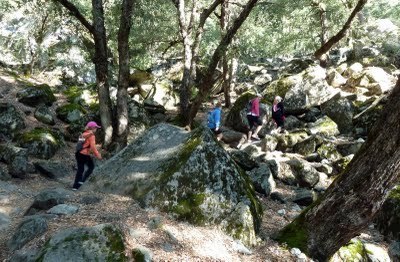 To their credit, even after we explained the goal of the day (we conveniently left out the Empire State Building part) none of the kids shrunk from the challenge – which is a good thing, because the trail demands full commitment right off the bat, as it starts with a series of more than 60 switchbacks that help you gain altitude in a hurry – approximately 1000' in the first mile.
To their credit, even after we explained the goal of the day (we conveniently left out the Empire State Building part) none of the kids shrunk from the challenge – which is a good thing, because the trail demands full commitment right off the bat, as it starts with a series of more than 60 switchbacks that help you gain altitude in a hurry – approximately 1000' in the first mile.
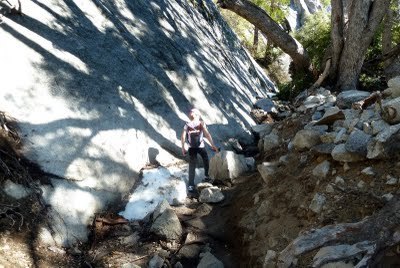 After a mile and a half or so, the trail levels out, just as the footing starts to get tricky. It's a nice courtesy of the trail to introduce these challenges one at a time, to keep you from getting too discouraged once you hit the sections that are both steep and technical. You also enjoy* a nice little downhill portion before commencing the real difficult stretch of trail ahead.
After a mile and a half or so, the trail levels out, just as the footing starts to get tricky. It's a nice courtesy of the trail to introduce these challenges one at a time, to keep you from getting too discouraged once you hit the sections that are both steep and technical. You also enjoy* a nice little downhill portion before commencing the real difficult stretch of trail ahead.
(*"Enjoy" might be the wrong term, since you know you'll have to make the elevation back up in the very near future. As my father-in-law put it, "I hate giving back elevation" – and as you might guess, he wasn't thrilled with the brief downhill part.)
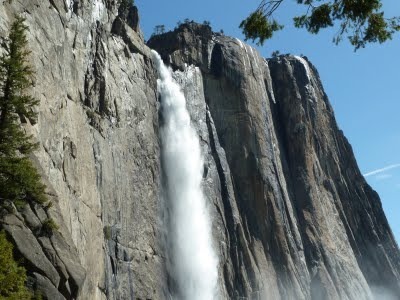 The good news is that just as the trail shifts to expert level, you have some killer views of Yosemite Falls, and get close enough to get saturated by the spray if you linger for too long.
The good news is that just as the trail shifts to expert level, you have some killer views of Yosemite Falls, and get close enough to get saturated by the spray if you linger for too long.
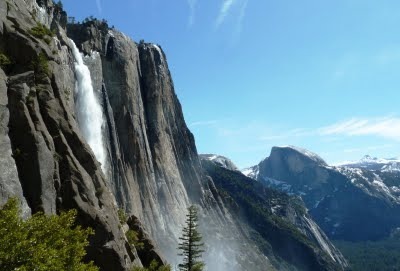 And as you continue even higher, you get the "only one spot in Yosemite to see this" vantage point of having both Yosemite Falls and the face of Half Dome in your field of vision.
And as you continue even higher, you get the "only one spot in Yosemite to see this" vantage point of having both Yosemite Falls and the face of Half Dome in your field of vision.
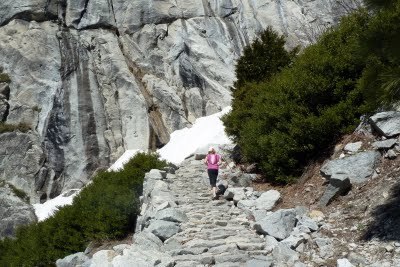 It was somewhere above 6000' elevation that the snow progressively became more of a factor; at first it started as decorative accents on either side of the trail …
It was somewhere above 6000' elevation that the snow progressively became more of a factor; at first it started as decorative accents on either side of the trail …
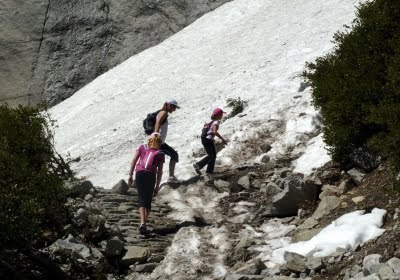 … before becoming enough of an impediment to make you alter your course, especially around switchbacks and turns …
… before becoming enough of an impediment to make you alter your course, especially around switchbacks and turns …
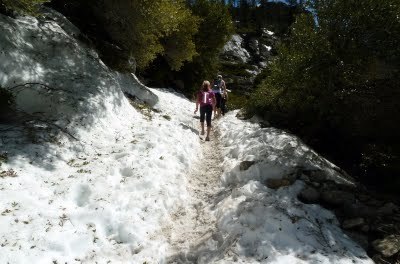 … then completely obscuring the trail except for a narrow footpath …
… then completely obscuring the trail except for a narrow footpath …
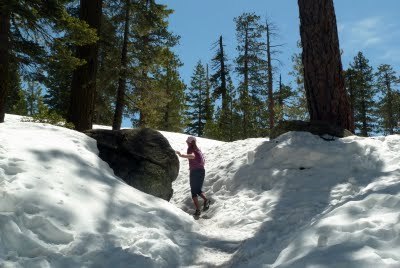 … before ultimately blanketing everything in sight, which thankfully didn't occur until just below the top of the climb. Incidentally, see that rock there? That's one of the ones I sat on while taking a "sun break" to warm my toes up a bit, as I mentioned in this post about wearing Vibrams in the snow.
… before ultimately blanketing everything in sight, which thankfully didn't occur until just below the top of the climb. Incidentally, see that rock there? That's one of the ones I sat on while taking a "sun break" to warm my toes up a bit, as I mentioned in this post about wearing Vibrams in the snow.
As for the kids, the snow seemed to energize them; approaching the last third of the climb, the girls started to drag just a bit, but as the snow got deeper and we got further and further into a winter landscape, they forgot that they were actually exercising and started goofing around in the snow. Either that, or the caffeinated CLIF Bloks my wife and I gave them about halfway up the hill were finally starting to kick in. (Seriously.)
Whatever the cause, they showed no signs of fatigue, throwing snowballs and making snowmen and generally having a blast …
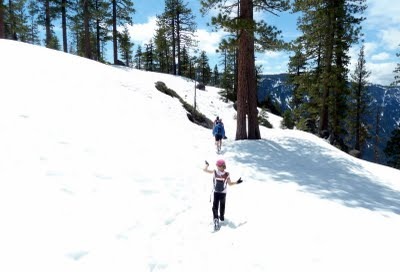 … until my toes were warm enough to finish the outbound leg by heading toward the overlook area, where (fortunately for me) the granite was completely dry under the glare of direct sunlight.
… until my toes were warm enough to finish the outbound leg by heading toward the overlook area, where (fortunately for me) the granite was completely dry under the glare of direct sunlight.
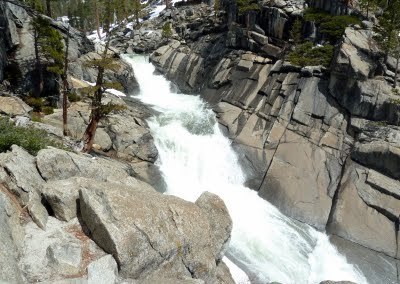 The Yosemite Falls overlook is one of the coolest spots in the park, but this "pre-fall" section is as close as the majority of my family got to seeing it ...
The Yosemite Falls overlook is one of the coolest spots in the park, but this "pre-fall" section is as close as the majority of my family got to seeing it ...
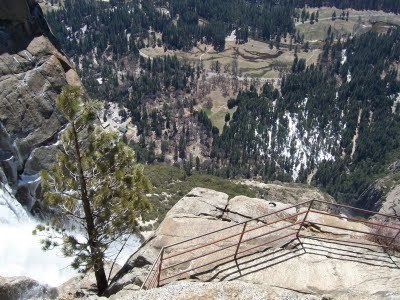 ... because the rest of the path to the overlook is a somewhat vertigo-inducing route down the face of the cliff …
... because the rest of the path to the overlook is a somewhat vertigo-inducing route down the face of the cliff …
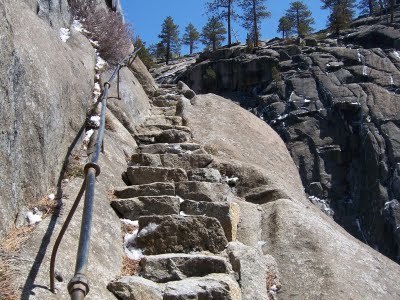 … with these narrow stairs and this small handrail the only thing to keep you from plunging over the side.
… with these narrow stairs and this small handrail the only thing to keep you from plunging over the side.
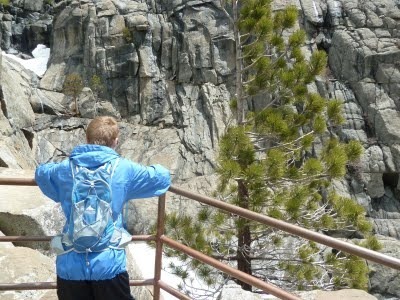 My son was the only one who felt compelled to stand at the edge by himself. Actually, that's not entirely true; my 7-year-old (remember, the one we deemed "most likely to tumble off a cliff or waterfall") also went down with us, but I kept one hand on her at all times, and for some reason it didn't seem like a good time to try playing around with my camera in the other hand. Call it a hunch.
My son was the only one who felt compelled to stand at the edge by himself. Actually, that's not entirely true; my 7-year-old (remember, the one we deemed "most likely to tumble off a cliff or waterfall") also went down with us, but I kept one hand on her at all times, and for some reason it didn't seem like a good time to try playing around with my camera in the other hand. Call it a hunch.
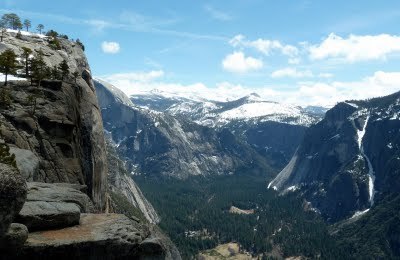 We returned to the safer part of the overlook and enjoyed the views while having another lunch at the top of Yosemite – our second in two days, with one on each side of the valley. Not too shabby for a first family trip, I'd say.
We returned to the safer part of the overlook and enjoyed the views while having another lunch at the top of Yosemite – our second in two days, with one on each side of the valley. Not too shabby for a first family trip, I'd say.
 I took this photo after lunch because it was such an oddity: my wife, who's waaaaayy more paranoid than me when it comes to standing near steep dropoffs, and who has deferred two separate opportunities to overlook Yosemite Falls, randomly walked to the edge of the cliff and called our son over to point out the view of Yosemite Lodge in the distance far below. This also seems like a nice moment to point out that I don't account for 100% of the crazy in our family – my wife's good for at least a percent or two sometimes.
I took this photo after lunch because it was such an oddity: my wife, who's waaaaayy more paranoid than me when it comes to standing near steep dropoffs, and who has deferred two separate opportunities to overlook Yosemite Falls, randomly walked to the edge of the cliff and called our son over to point out the view of Yosemite Lodge in the distance far below. This also seems like a nice moment to point out that I don't account for 100% of the crazy in our family – my wife's good for at least a percent or two sometimes.
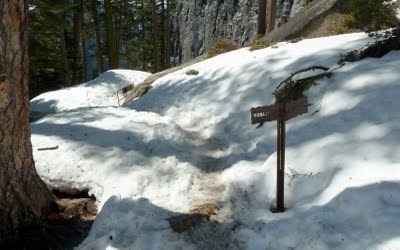 Once we had our fill of both food and the beautiful views, the return to the floor of the valley was one of those situations where the journey down takes almost as long as the way up. By midday, the paths of snow had turned slushy and slippery, and the combination of technical footing and steep descents dictated that we go fairly cautiously, especially in the company of little legs that had completed their second major day of climbing in a row. We didn't have any serious problems, though …
Once we had our fill of both food and the beautiful views, the return to the floor of the valley was one of those situations where the journey down takes almost as long as the way up. By midday, the paths of snow had turned slushy and slippery, and the combination of technical footing and steep descents dictated that we go fairly cautiously, especially in the company of little legs that had completed their second major day of climbing in a row. We didn't have any serious problems, though …
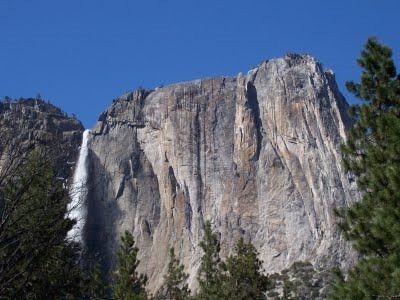 … and before we knew it were back on the valley floor, looking back up at where we had just been. There's nothing quite like the feeling of "did we really just climb to the top of that thing?" to instill a sense of accomplishment in the kids … and OK, in the adults as well.
… and before we knew it were back on the valley floor, looking back up at where we had just been. There's nothing quite like the feeling of "did we really just climb to the top of that thing?" to instill a sense of accomplishment in the kids … and OK, in the adults as well.
In the final analysis, all of our kids performed wonderfully with both of our day hikes, and proved without a shadow of a doubt that our concern about their ability was somewhat unfounded. It's worth pointing out that my wife and I wouldn't describe any of our children as remarkable athletes; they're just everyday kids who occasionally need some encouragement to be active, but generally enjoy goofing around outdoors and exploring the natural environment. Adventures like this seem like the kind of thing that should be commonplace with children, but are sadly becoming more of the exception in modern society.
In many ways, children might be seen as little microcosms of endurance athletes: if they're motivated and determined to accomplish something, they're capable of overcoming just about any perceived physical limitation that might stand in their way. And fortunately for my wife and me, the beauty of Yosemite was a perfect means of stimulating our kids' ambition to push themselves further than normal in hopes of finding a significant physical and spiritual reward.
The really cool thing is that this effect works just as well on grown-ups as it does on kids – which is why I'm hopeful that this will be the first of many family outings into Yosemite.
*See other photo tours under tab at top of page
Get updates as soon as they're posted! Click here to subscribe to Running and Rambling.
Check out the Running Life book for a collection of our most popular columns.

We didn't tell the kids this at the time, but the Mist Trail was our "building confidence" hike – because we knew that the challenge of Day 2 would be significantly greater.
 Our objective for the day was Yosemite Falls, which at roughly 4 miles from our starting point at Yosemite Lodge was only slightly longer than the previous day's outing, but has an additional 700' of climbing, much of it over very irregular rocky terrain. (I've also profiled this hike in a previous photo tour from two years ago.) If there are any city folk reading this who want a frame of reference, the hike is roughly the equivalent of climbing up two Empire State Buildings – except that instead of having an enclosed stairwell and railing to hold onto, the path on the top third of the climb is covered in snow, frequently gets slippery, and is less than 1 foot wide. Hopefully that helps.
Our objective for the day was Yosemite Falls, which at roughly 4 miles from our starting point at Yosemite Lodge was only slightly longer than the previous day's outing, but has an additional 700' of climbing, much of it over very irregular rocky terrain. (I've also profiled this hike in a previous photo tour from two years ago.) If there are any city folk reading this who want a frame of reference, the hike is roughly the equivalent of climbing up two Empire State Buildings – except that instead of having an enclosed stairwell and railing to hold onto, the path on the top third of the climb is covered in snow, frequently gets slippery, and is less than 1 foot wide. Hopefully that helps. To their credit, even after we explained the goal of the day (we conveniently left out the Empire State Building part) none of the kids shrunk from the challenge – which is a good thing, because the trail demands full commitment right off the bat, as it starts with a series of more than 60 switchbacks that help you gain altitude in a hurry – approximately 1000' in the first mile.
To their credit, even after we explained the goal of the day (we conveniently left out the Empire State Building part) none of the kids shrunk from the challenge – which is a good thing, because the trail demands full commitment right off the bat, as it starts with a series of more than 60 switchbacks that help you gain altitude in a hurry – approximately 1000' in the first mile. After a mile and a half or so, the trail levels out, just as the footing starts to get tricky. It's a nice courtesy of the trail to introduce these challenges one at a time, to keep you from getting too discouraged once you hit the sections that are both steep and technical. You also enjoy* a nice little downhill portion before commencing the real difficult stretch of trail ahead.
After a mile and a half or so, the trail levels out, just as the footing starts to get tricky. It's a nice courtesy of the trail to introduce these challenges one at a time, to keep you from getting too discouraged once you hit the sections that are both steep and technical. You also enjoy* a nice little downhill portion before commencing the real difficult stretch of trail ahead.(*"Enjoy" might be the wrong term, since you know you'll have to make the elevation back up in the very near future. As my father-in-law put it, "I hate giving back elevation" – and as you might guess, he wasn't thrilled with the brief downhill part.)
 The good news is that just as the trail shifts to expert level, you have some killer views of Yosemite Falls, and get close enough to get saturated by the spray if you linger for too long.
The good news is that just as the trail shifts to expert level, you have some killer views of Yosemite Falls, and get close enough to get saturated by the spray if you linger for too long. And as you continue even higher, you get the "only one spot in Yosemite to see this" vantage point of having both Yosemite Falls and the face of Half Dome in your field of vision.
And as you continue even higher, you get the "only one spot in Yosemite to see this" vantage point of having both Yosemite Falls and the face of Half Dome in your field of vision. It was somewhere above 6000' elevation that the snow progressively became more of a factor; at first it started as decorative accents on either side of the trail …
It was somewhere above 6000' elevation that the snow progressively became more of a factor; at first it started as decorative accents on either side of the trail … … before becoming enough of an impediment to make you alter your course, especially around switchbacks and turns …
… before becoming enough of an impediment to make you alter your course, especially around switchbacks and turns … … then completely obscuring the trail except for a narrow footpath …
… then completely obscuring the trail except for a narrow footpath … … before ultimately blanketing everything in sight, which thankfully didn't occur until just below the top of the climb. Incidentally, see that rock there? That's one of the ones I sat on while taking a "sun break" to warm my toes up a bit, as I mentioned in this post about wearing Vibrams in the snow.
… before ultimately blanketing everything in sight, which thankfully didn't occur until just below the top of the climb. Incidentally, see that rock there? That's one of the ones I sat on while taking a "sun break" to warm my toes up a bit, as I mentioned in this post about wearing Vibrams in the snow.As for the kids, the snow seemed to energize them; approaching the last third of the climb, the girls started to drag just a bit, but as the snow got deeper and we got further and further into a winter landscape, they forgot that they were actually exercising and started goofing around in the snow. Either that, or the caffeinated CLIF Bloks my wife and I gave them about halfway up the hill were finally starting to kick in. (Seriously.)
Whatever the cause, they showed no signs of fatigue, throwing snowballs and making snowmen and generally having a blast …
 … until my toes were warm enough to finish the outbound leg by heading toward the overlook area, where (fortunately for me) the granite was completely dry under the glare of direct sunlight.
… until my toes were warm enough to finish the outbound leg by heading toward the overlook area, where (fortunately for me) the granite was completely dry under the glare of direct sunlight. The Yosemite Falls overlook is one of the coolest spots in the park, but this "pre-fall" section is as close as the majority of my family got to seeing it ...
The Yosemite Falls overlook is one of the coolest spots in the park, but this "pre-fall" section is as close as the majority of my family got to seeing it ... ... because the rest of the path to the overlook is a somewhat vertigo-inducing route down the face of the cliff …
... because the rest of the path to the overlook is a somewhat vertigo-inducing route down the face of the cliff … … with these narrow stairs and this small handrail the only thing to keep you from plunging over the side.
… with these narrow stairs and this small handrail the only thing to keep you from plunging over the side. My son was the only one who felt compelled to stand at the edge by himself. Actually, that's not entirely true; my 7-year-old (remember, the one we deemed "most likely to tumble off a cliff or waterfall") also went down with us, but I kept one hand on her at all times, and for some reason it didn't seem like a good time to try playing around with my camera in the other hand. Call it a hunch.
My son was the only one who felt compelled to stand at the edge by himself. Actually, that's not entirely true; my 7-year-old (remember, the one we deemed "most likely to tumble off a cliff or waterfall") also went down with us, but I kept one hand on her at all times, and for some reason it didn't seem like a good time to try playing around with my camera in the other hand. Call it a hunch. We returned to the safer part of the overlook and enjoyed the views while having another lunch at the top of Yosemite – our second in two days, with one on each side of the valley. Not too shabby for a first family trip, I'd say.
We returned to the safer part of the overlook and enjoyed the views while having another lunch at the top of Yosemite – our second in two days, with one on each side of the valley. Not too shabby for a first family trip, I'd say. I took this photo after lunch because it was such an oddity: my wife, who's waaaaayy more paranoid than me when it comes to standing near steep dropoffs, and who has deferred two separate opportunities to overlook Yosemite Falls, randomly walked to the edge of the cliff and called our son over to point out the view of Yosemite Lodge in the distance far below. This also seems like a nice moment to point out that I don't account for 100% of the crazy in our family – my wife's good for at least a percent or two sometimes.
I took this photo after lunch because it was such an oddity: my wife, who's waaaaayy more paranoid than me when it comes to standing near steep dropoffs, and who has deferred two separate opportunities to overlook Yosemite Falls, randomly walked to the edge of the cliff and called our son over to point out the view of Yosemite Lodge in the distance far below. This also seems like a nice moment to point out that I don't account for 100% of the crazy in our family – my wife's good for at least a percent or two sometimes. Once we had our fill of both food and the beautiful views, the return to the floor of the valley was one of those situations where the journey down takes almost as long as the way up. By midday, the paths of snow had turned slushy and slippery, and the combination of technical footing and steep descents dictated that we go fairly cautiously, especially in the company of little legs that had completed their second major day of climbing in a row. We didn't have any serious problems, though …
Once we had our fill of both food and the beautiful views, the return to the floor of the valley was one of those situations where the journey down takes almost as long as the way up. By midday, the paths of snow had turned slushy and slippery, and the combination of technical footing and steep descents dictated that we go fairly cautiously, especially in the company of little legs that had completed their second major day of climbing in a row. We didn't have any serious problems, though … … and before we knew it were back on the valley floor, looking back up at where we had just been. There's nothing quite like the feeling of "did we really just climb to the top of that thing?" to instill a sense of accomplishment in the kids … and OK, in the adults as well.
… and before we knew it were back on the valley floor, looking back up at where we had just been. There's nothing quite like the feeling of "did we really just climb to the top of that thing?" to instill a sense of accomplishment in the kids … and OK, in the adults as well.In the final analysis, all of our kids performed wonderfully with both of our day hikes, and proved without a shadow of a doubt that our concern about their ability was somewhat unfounded. It's worth pointing out that my wife and I wouldn't describe any of our children as remarkable athletes; they're just everyday kids who occasionally need some encouragement to be active, but generally enjoy goofing around outdoors and exploring the natural environment. Adventures like this seem like the kind of thing that should be commonplace with children, but are sadly becoming more of the exception in modern society.
In many ways, children might be seen as little microcosms of endurance athletes: if they're motivated and determined to accomplish something, they're capable of overcoming just about any perceived physical limitation that might stand in their way. And fortunately for my wife and me, the beauty of Yosemite was a perfect means of stimulating our kids' ambition to push themselves further than normal in hopes of finding a significant physical and spiritual reward.
The really cool thing is that this effect works just as well on grown-ups as it does on kids – which is why I'm hopeful that this will be the first of many family outings into Yosemite.
*See other photo tours under tab at top of page
Get updates as soon as they're posted! Click here to subscribe to Running and Rambling.
Check out the Running Life book for a collection of our most popular columns.

Published on April 26, 2011 17:42
April 25, 2011
Hiking Yosemite With Kids, Part 1: Mist Trail
Admin note: this was intended as a single post, but in true Running and Rambling fashion, I got carried away with things, and before I knew it I had a monster post on my hands. So we're doing this as a two-part deal, on back to back days tonight and tomorrow. Feel free to comment on one, both, or (sigh) neither – whatever you prefer is fine with me. At this point I just need to rest my fingers for a while.
**
For each of the past few years, my wife and I have made a springtime pilgrimage to Yosemite National Park. On each of these trips, one of our most frequent topics of conversation while hiking throughout the valley has been when we thought our kids would be ready to join us on similar outings.
 It was a more complicated question than just taking a family trip together; after all, there are plenty of families who bring young kids to Yosemite to walk around the meadow, explore the trails of the valley floor, or camp in the shadow of the mountains. But since we live in a rural area, our kids are able to experience a lot of natural beauty and do those outdoorsy activities at home. If my wife and I were going to give up our annual dose of seclusion to drag the kids along on a multi-day excursion, they had to be able to handle exploring the park in the same way that we enjoy. They also had to be able to appreciate the majestic grandeur of Yosemite, and capable of putting in the long hours that it might take to appreciate some of its unique features up close.
It was a more complicated question than just taking a family trip together; after all, there are plenty of families who bring young kids to Yosemite to walk around the meadow, explore the trails of the valley floor, or camp in the shadow of the mountains. But since we live in a rural area, our kids are able to experience a lot of natural beauty and do those outdoorsy activities at home. If my wife and I were going to give up our annual dose of seclusion to drag the kids along on a multi-day excursion, they had to be able to handle exploring the park in the same way that we enjoy. They also had to be able to appreciate the majestic grandeur of Yosemite, and capable of putting in the long hours that it might take to appreciate some of its unique features up close.
In other words, they had to be pretty strong little hikers.
Last fall, we finally decided to go for it, and made reservations to visit the park during this year's spring break. However, we still weren't fully convinced that our youngsters were up to some of the challenges, so after the first of the year we spent a lot of weekends hiking in the hills of Carmel Valley, all the while counseling them that the trails of Yosemite were even steeper, with more tricky footing, and more unpredictably variable weather conditions. We also assured them that all their practice would be totally worth it. They gradually paid their dues on our home trails, and last week was time for them to cash in and have some fun.
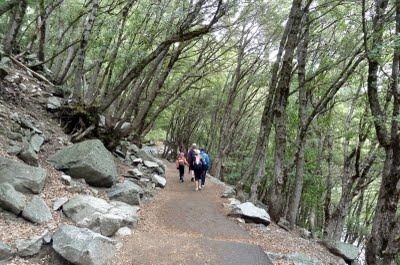 In addition to me and my wife, the cast of characters that set out on our first morning in Yosemite included our 12-year-old son, who was already a veteran of climbing up Sentinel Dome; honestly, we weren't too worried about him. Our 9-year-old daughter runs with me on a weekly basis, but also shares my affection for wasting the day away with a good book underneath a warm blanket, and would probably be the first one to get discouraged if conditions got too wet, cold, muddy, or otherwise uncomfortable. However, she was also recently drafted into the Running and Rambling gear testing collective, so she was probably feeling a bit of pressure to finish the hike to increase her chances of getting more free stuff in the future. I considered that to be a good thing.
In addition to me and my wife, the cast of characters that set out on our first morning in Yosemite included our 12-year-old son, who was already a veteran of climbing up Sentinel Dome; honestly, we weren't too worried about him. Our 9-year-old daughter runs with me on a weekly basis, but also shares my affection for wasting the day away with a good book underneath a warm blanket, and would probably be the first one to get discouraged if conditions got too wet, cold, muddy, or otherwise uncomfortable. However, she was also recently drafted into the Running and Rambling gear testing collective, so she was probably feeling a bit of pressure to finish the hike to increase her chances of getting more free stuff in the future. I considered that to be a good thing.
The biggest question mark going into the hikes was our 7-year-old daughter, who had the smallest legs of the group, but is also something of a firecracker. We ultimately decided that if we could channel a portion of her energy for relentless chatter into simply moving one foot in front of the other, she'd be fine. However, she also has the shortest attention span of the group and is prone to wandering off on her own without warning, so she earned "most likely to wind up tumbling off the edge of a cliff or waterfall somewhere" status with my wife and me. Fortunately, since you're seeing this report on my blog instead of the evening news, you pretty much know how that turned out.
Our first day would be spent on the Mist Trail, which I've already documented more thoroughly in this photo tour. It's about 3.5 miles in one direction, rising nearly 2000 feet while passing by two spectacular waterfalls. It's one of the most popular hikes in the valley …
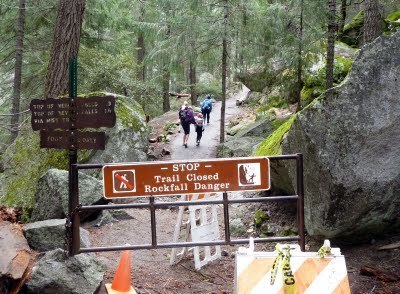 … when it's open, that is. When the trail's still officially closed for the winter, you'd be surprised at how effectively that scares the tourist traffic away. In our case, it also triggered a nice early-morning discussion of situational ethics, such as when it might be OK to disregard the rules to do something that is totally cool. Yes, it's a slippery slope of logic: when the objective is seeing a cool waterfall, I'm completely OK with it, but if my youngest daughter ever tells me that she's thinking about BASE jumping off Half Dome someday, you bet your ass that I'll say "Absolutely not – it's against park rules!" So let's just say I take some liberties with parental authority, and move on.
… when it's open, that is. When the trail's still officially closed for the winter, you'd be surprised at how effectively that scares the tourist traffic away. In our case, it also triggered a nice early-morning discussion of situational ethics, such as when it might be OK to disregard the rules to do something that is totally cool. Yes, it's a slippery slope of logic: when the objective is seeing a cool waterfall, I'm completely OK with it, but if my youngest daughter ever tells me that she's thinking about BASE jumping off Half Dome someday, you bet your ass that I'll say "Absolutely not – it's against park rules!" So let's just say I take some liberties with parental authority, and move on.
 The Mist Trail more than lived up to its name, as we made our way up the steep granite staircase that was soaked from the spray of nearby Vernal Fall.
The Mist Trail more than lived up to its name, as we made our way up the steep granite staircase that was soaked from the spray of nearby Vernal Fall.
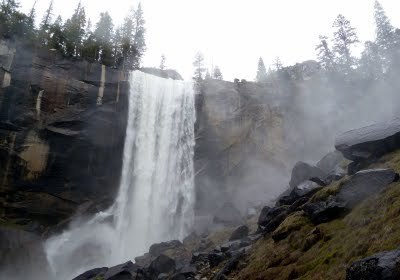 Remember what I said about having natural beauty at home? Well, um … we don't have a waterfall like this in Carmel Valley. We ended up timing our trip almost perfectly for waterfall volume, as heavy late-winter snowfall had melted quickly over the previous couple of weeks of sunshine; consequently, all of the falls we saw on our trip were in full-fledged boom mode.
Remember what I said about having natural beauty at home? Well, um … we don't have a waterfall like this in Carmel Valley. We ended up timing our trip almost perfectly for waterfall volume, as heavy late-winter snowfall had melted quickly over the previous couple of weeks of sunshine; consequently, all of the falls we saw on our trip were in full-fledged boom mode.
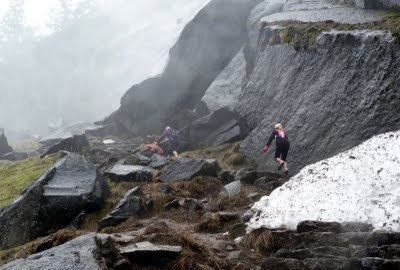 For the most part, the trail to Vernal Fall was passable, aside from a few little snowbanks to maneuver around here and there. However, between cool temperatures, an overcast sky and getting increasingly soaked, the chill factor on this stretch of trail became pretty bad. But to our pleasant surprise, nobody really complained about it.
For the most part, the trail to Vernal Fall was passable, aside from a few little snowbanks to maneuver around here and there. However, between cool temperatures, an overcast sky and getting increasingly soaked, the chill factor on this stretch of trail became pretty bad. But to our pleasant surprise, nobody really complained about it.
 It also helped that by this point we were close to the top of Vernal Fall, where we could dry off above the waterfall spray, and where we had the place completely to ourselves. (Must have had something to do with that closed trail thing down below.) Each of our kids stood on the precipice of the 480' vertical drop – and that's pretty much all it took for them to be sold on Yosemite.
It also helped that by this point we were close to the top of Vernal Fall, where we could dry off above the waterfall spray, and where we had the place completely to ourselves. (Must have had something to do with that closed trail thing down below.) Each of our kids stood on the precipice of the 480' vertical drop – and that's pretty much all it took for them to be sold on Yosemite.
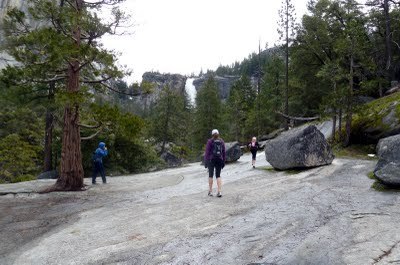 After a brief break, we continued up the trail with the final objective for the day, Nevada Fall, looming in the distance ahead.
After a brief break, we continued up the trail with the final objective for the day, Nevada Fall, looming in the distance ahead.
 The upper portion of the Mist Trail is essentially one long staircase, much of it in direct line of sight with Nevada Fall – but since the spray from this fall blows in the opposite direction, it's not nearly as cold as the section below Vernal Fall.
The upper portion of the Mist Trail is essentially one long staircase, much of it in direct line of sight with Nevada Fall – but since the spray from this fall blows in the opposite direction, it's not nearly as cold as the section below Vernal Fall.
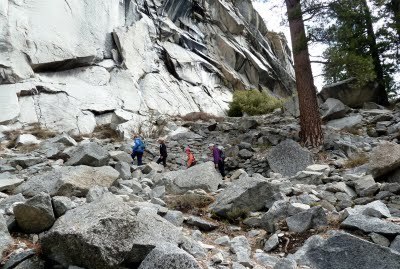 Staircases gradually turn to switchbacks, but by this time we were close enough to the top that excitement seemed to override fatigue pretty easily for all of our kids.
Staircases gradually turn to switchbacks, but by this time we were close enough to the top that excitement seemed to override fatigue pretty easily for all of our kids.
 At the top of Nevada Fall, we once again had the whole rock to ourselves, which made for a perfect lunch spot after a few hours of climbing. It was also a nice opportunity for my daughter to model the CamelBak pack she was testing; I'll have a full review here in the next week or two, but suffice it to say we were both very pleased with it.
At the top of Nevada Fall, we once again had the whole rock to ourselves, which made for a perfect lunch spot after a few hours of climbing. It was also a nice opportunity for my daughter to model the CamelBak pack she was testing; I'll have a full review here in the next week or two, but suffice it to say we were both very pleased with it.
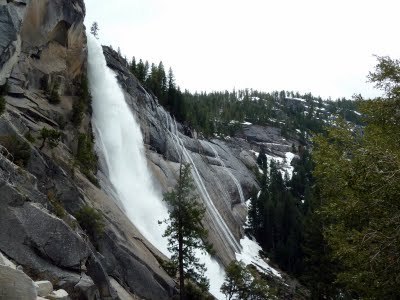 There are two ways to descend from the top of Nevada Fall: via the John Muir Trail, which is the thin line of snow that's barely visible at right-center in the photo above, or to retrace our steps down the Mist Trail. Luckily, we chose to stay out of the snow as much as possible on this hike … because unbeknownst to us, on the following day we'd see a ton of it.
There are two ways to descend from the top of Nevada Fall: via the John Muir Trail, which is the thin line of snow that's barely visible at right-center in the photo above, or to retrace our steps down the Mist Trail. Luckily, we chose to stay out of the snow as much as possible on this hike … because unbeknownst to us, on the following day we'd see a ton of it.
Which is where we'll pick up the story in Part 2 next time.
*See other photo tours under tab at top of page
Get updates as soon as they're posted! Click here to subscribe to Running and Rambling.
Check out the Running Life book for a collection of our most popular columns.

**
For each of the past few years, my wife and I have made a springtime pilgrimage to Yosemite National Park. On each of these trips, one of our most frequent topics of conversation while hiking throughout the valley has been when we thought our kids would be ready to join us on similar outings.
 It was a more complicated question than just taking a family trip together; after all, there are plenty of families who bring young kids to Yosemite to walk around the meadow, explore the trails of the valley floor, or camp in the shadow of the mountains. But since we live in a rural area, our kids are able to experience a lot of natural beauty and do those outdoorsy activities at home. If my wife and I were going to give up our annual dose of seclusion to drag the kids along on a multi-day excursion, they had to be able to handle exploring the park in the same way that we enjoy. They also had to be able to appreciate the majestic grandeur of Yosemite, and capable of putting in the long hours that it might take to appreciate some of its unique features up close.
It was a more complicated question than just taking a family trip together; after all, there are plenty of families who bring young kids to Yosemite to walk around the meadow, explore the trails of the valley floor, or camp in the shadow of the mountains. But since we live in a rural area, our kids are able to experience a lot of natural beauty and do those outdoorsy activities at home. If my wife and I were going to give up our annual dose of seclusion to drag the kids along on a multi-day excursion, they had to be able to handle exploring the park in the same way that we enjoy. They also had to be able to appreciate the majestic grandeur of Yosemite, and capable of putting in the long hours that it might take to appreciate some of its unique features up close.In other words, they had to be pretty strong little hikers.
Last fall, we finally decided to go for it, and made reservations to visit the park during this year's spring break. However, we still weren't fully convinced that our youngsters were up to some of the challenges, so after the first of the year we spent a lot of weekends hiking in the hills of Carmel Valley, all the while counseling them that the trails of Yosemite were even steeper, with more tricky footing, and more unpredictably variable weather conditions. We also assured them that all their practice would be totally worth it. They gradually paid their dues on our home trails, and last week was time for them to cash in and have some fun.
 In addition to me and my wife, the cast of characters that set out on our first morning in Yosemite included our 12-year-old son, who was already a veteran of climbing up Sentinel Dome; honestly, we weren't too worried about him. Our 9-year-old daughter runs with me on a weekly basis, but also shares my affection for wasting the day away with a good book underneath a warm blanket, and would probably be the first one to get discouraged if conditions got too wet, cold, muddy, or otherwise uncomfortable. However, she was also recently drafted into the Running and Rambling gear testing collective, so she was probably feeling a bit of pressure to finish the hike to increase her chances of getting more free stuff in the future. I considered that to be a good thing.
In addition to me and my wife, the cast of characters that set out on our first morning in Yosemite included our 12-year-old son, who was already a veteran of climbing up Sentinel Dome; honestly, we weren't too worried about him. Our 9-year-old daughter runs with me on a weekly basis, but also shares my affection for wasting the day away with a good book underneath a warm blanket, and would probably be the first one to get discouraged if conditions got too wet, cold, muddy, or otherwise uncomfortable. However, she was also recently drafted into the Running and Rambling gear testing collective, so she was probably feeling a bit of pressure to finish the hike to increase her chances of getting more free stuff in the future. I considered that to be a good thing.The biggest question mark going into the hikes was our 7-year-old daughter, who had the smallest legs of the group, but is also something of a firecracker. We ultimately decided that if we could channel a portion of her energy for relentless chatter into simply moving one foot in front of the other, she'd be fine. However, she also has the shortest attention span of the group and is prone to wandering off on her own without warning, so she earned "most likely to wind up tumbling off the edge of a cliff or waterfall somewhere" status with my wife and me. Fortunately, since you're seeing this report on my blog instead of the evening news, you pretty much know how that turned out.
Our first day would be spent on the Mist Trail, which I've already documented more thoroughly in this photo tour. It's about 3.5 miles in one direction, rising nearly 2000 feet while passing by two spectacular waterfalls. It's one of the most popular hikes in the valley …
 … when it's open, that is. When the trail's still officially closed for the winter, you'd be surprised at how effectively that scares the tourist traffic away. In our case, it also triggered a nice early-morning discussion of situational ethics, such as when it might be OK to disregard the rules to do something that is totally cool. Yes, it's a slippery slope of logic: when the objective is seeing a cool waterfall, I'm completely OK with it, but if my youngest daughter ever tells me that she's thinking about BASE jumping off Half Dome someday, you bet your ass that I'll say "Absolutely not – it's against park rules!" So let's just say I take some liberties with parental authority, and move on.
… when it's open, that is. When the trail's still officially closed for the winter, you'd be surprised at how effectively that scares the tourist traffic away. In our case, it also triggered a nice early-morning discussion of situational ethics, such as when it might be OK to disregard the rules to do something that is totally cool. Yes, it's a slippery slope of logic: when the objective is seeing a cool waterfall, I'm completely OK with it, but if my youngest daughter ever tells me that she's thinking about BASE jumping off Half Dome someday, you bet your ass that I'll say "Absolutely not – it's against park rules!" So let's just say I take some liberties with parental authority, and move on. The Mist Trail more than lived up to its name, as we made our way up the steep granite staircase that was soaked from the spray of nearby Vernal Fall.
The Mist Trail more than lived up to its name, as we made our way up the steep granite staircase that was soaked from the spray of nearby Vernal Fall. Remember what I said about having natural beauty at home? Well, um … we don't have a waterfall like this in Carmel Valley. We ended up timing our trip almost perfectly for waterfall volume, as heavy late-winter snowfall had melted quickly over the previous couple of weeks of sunshine; consequently, all of the falls we saw on our trip were in full-fledged boom mode.
Remember what I said about having natural beauty at home? Well, um … we don't have a waterfall like this in Carmel Valley. We ended up timing our trip almost perfectly for waterfall volume, as heavy late-winter snowfall had melted quickly over the previous couple of weeks of sunshine; consequently, all of the falls we saw on our trip were in full-fledged boom mode. For the most part, the trail to Vernal Fall was passable, aside from a few little snowbanks to maneuver around here and there. However, between cool temperatures, an overcast sky and getting increasingly soaked, the chill factor on this stretch of trail became pretty bad. But to our pleasant surprise, nobody really complained about it.
For the most part, the trail to Vernal Fall was passable, aside from a few little snowbanks to maneuver around here and there. However, between cool temperatures, an overcast sky and getting increasingly soaked, the chill factor on this stretch of trail became pretty bad. But to our pleasant surprise, nobody really complained about it. It also helped that by this point we were close to the top of Vernal Fall, where we could dry off above the waterfall spray, and where we had the place completely to ourselves. (Must have had something to do with that closed trail thing down below.) Each of our kids stood on the precipice of the 480' vertical drop – and that's pretty much all it took for them to be sold on Yosemite.
It also helped that by this point we were close to the top of Vernal Fall, where we could dry off above the waterfall spray, and where we had the place completely to ourselves. (Must have had something to do with that closed trail thing down below.) Each of our kids stood on the precipice of the 480' vertical drop – and that's pretty much all it took for them to be sold on Yosemite. After a brief break, we continued up the trail with the final objective for the day, Nevada Fall, looming in the distance ahead.
After a brief break, we continued up the trail with the final objective for the day, Nevada Fall, looming in the distance ahead. The upper portion of the Mist Trail is essentially one long staircase, much of it in direct line of sight with Nevada Fall – but since the spray from this fall blows in the opposite direction, it's not nearly as cold as the section below Vernal Fall.
The upper portion of the Mist Trail is essentially one long staircase, much of it in direct line of sight with Nevada Fall – but since the spray from this fall blows in the opposite direction, it's not nearly as cold as the section below Vernal Fall. Staircases gradually turn to switchbacks, but by this time we were close enough to the top that excitement seemed to override fatigue pretty easily for all of our kids.
Staircases gradually turn to switchbacks, but by this time we were close enough to the top that excitement seemed to override fatigue pretty easily for all of our kids. At the top of Nevada Fall, we once again had the whole rock to ourselves, which made for a perfect lunch spot after a few hours of climbing. It was also a nice opportunity for my daughter to model the CamelBak pack she was testing; I'll have a full review here in the next week or two, but suffice it to say we were both very pleased with it.
At the top of Nevada Fall, we once again had the whole rock to ourselves, which made for a perfect lunch spot after a few hours of climbing. It was also a nice opportunity for my daughter to model the CamelBak pack she was testing; I'll have a full review here in the next week or two, but suffice it to say we were both very pleased with it. There are two ways to descend from the top of Nevada Fall: via the John Muir Trail, which is the thin line of snow that's barely visible at right-center in the photo above, or to retrace our steps down the Mist Trail. Luckily, we chose to stay out of the snow as much as possible on this hike … because unbeknownst to us, on the following day we'd see a ton of it.
There are two ways to descend from the top of Nevada Fall: via the John Muir Trail, which is the thin line of snow that's barely visible at right-center in the photo above, or to retrace our steps down the Mist Trail. Luckily, we chose to stay out of the snow as much as possible on this hike … because unbeknownst to us, on the following day we'd see a ton of it.Which is where we'll pick up the story in Part 2 next time.
*See other photo tours under tab at top of page
Get updates as soon as they're posted! Click here to subscribe to Running and Rambling.
Check out the Running Life book for a collection of our most popular columns.

Published on April 25, 2011 13:12

